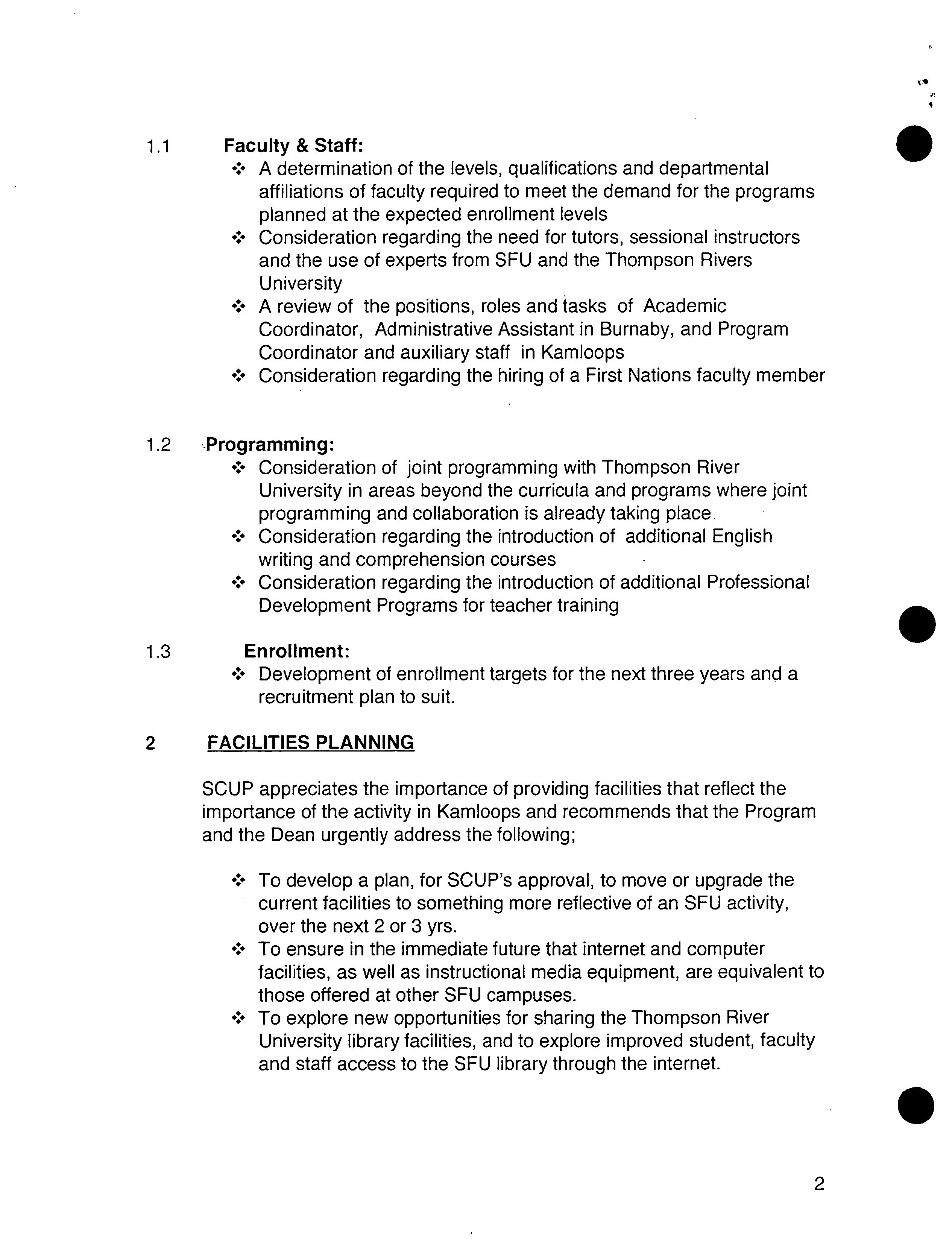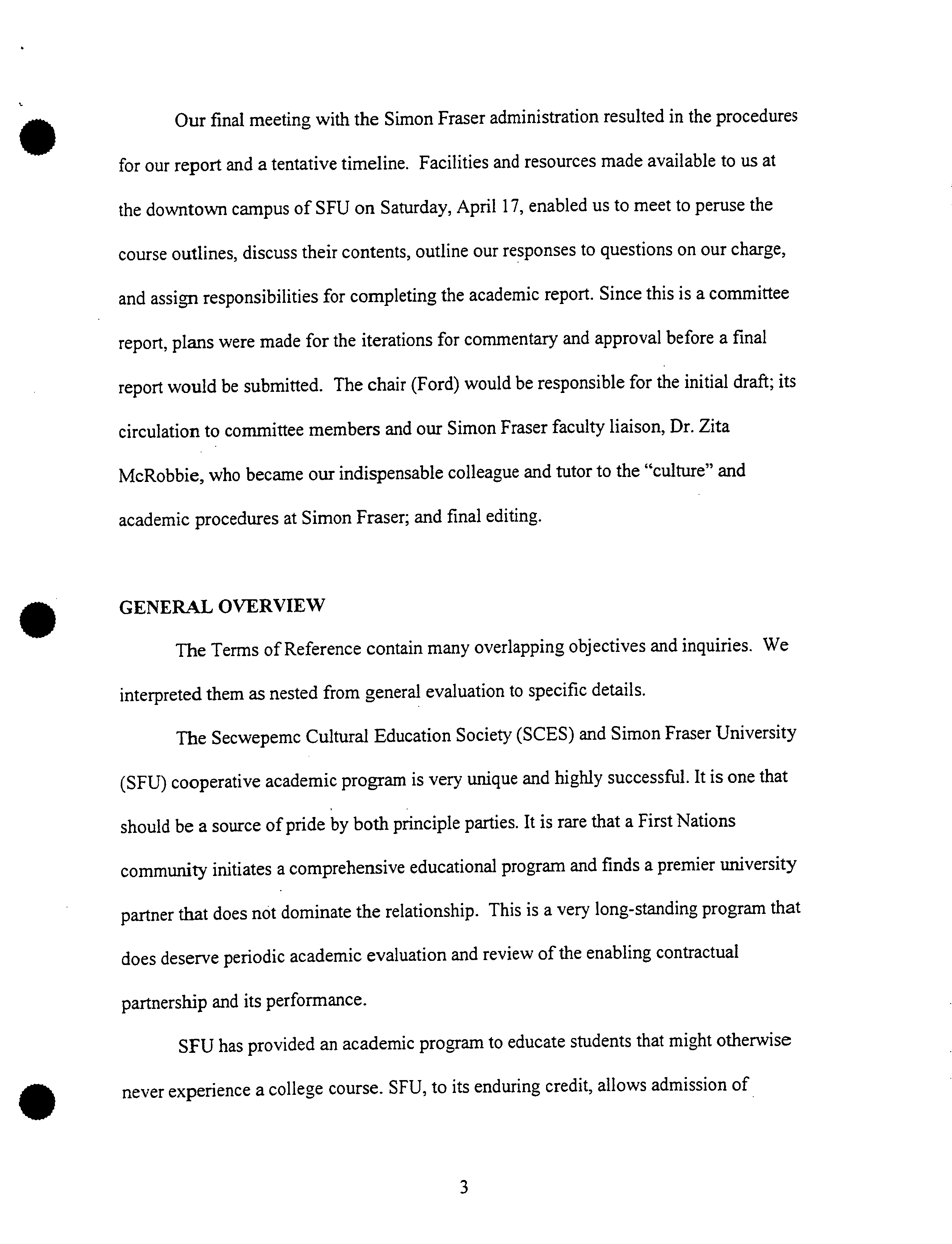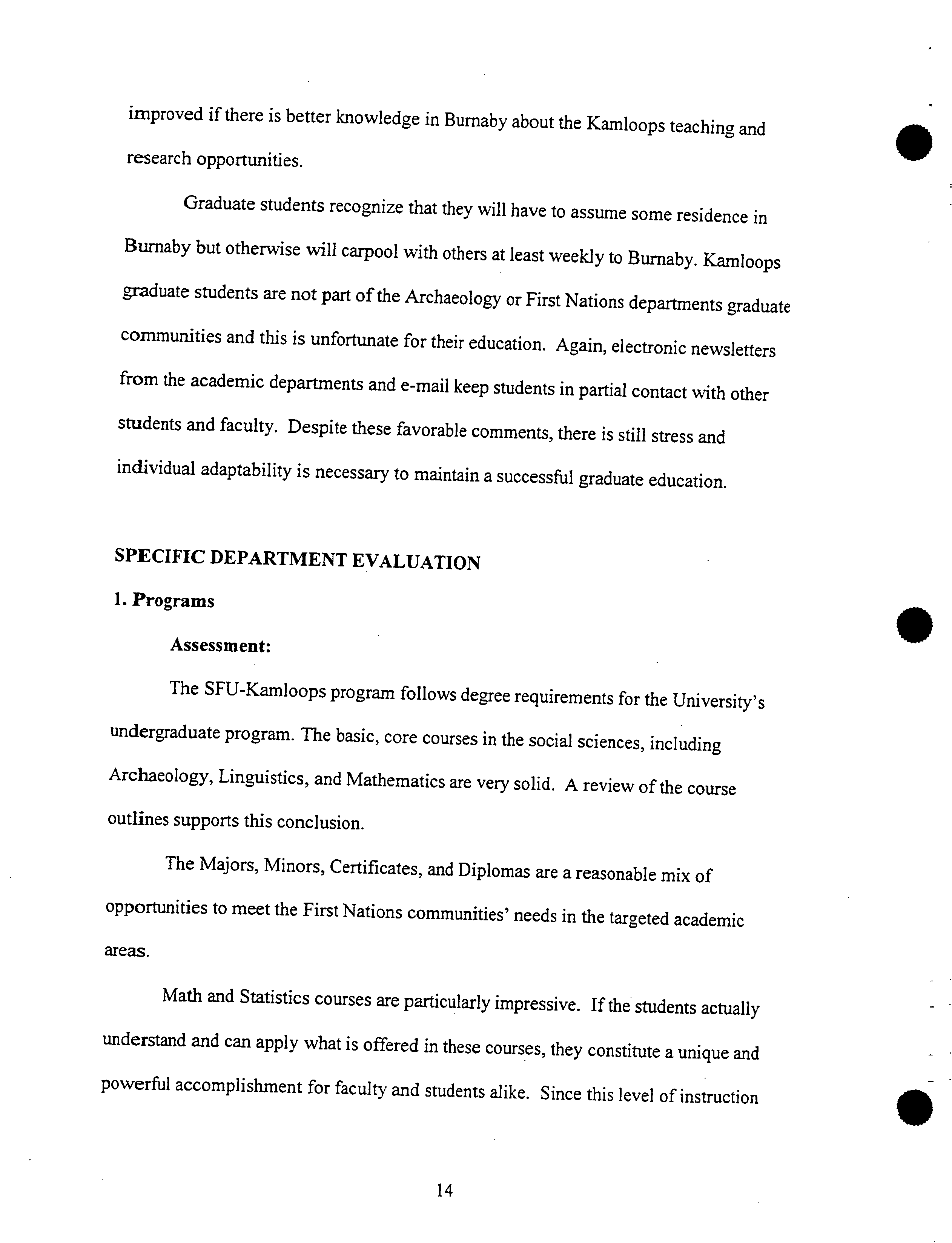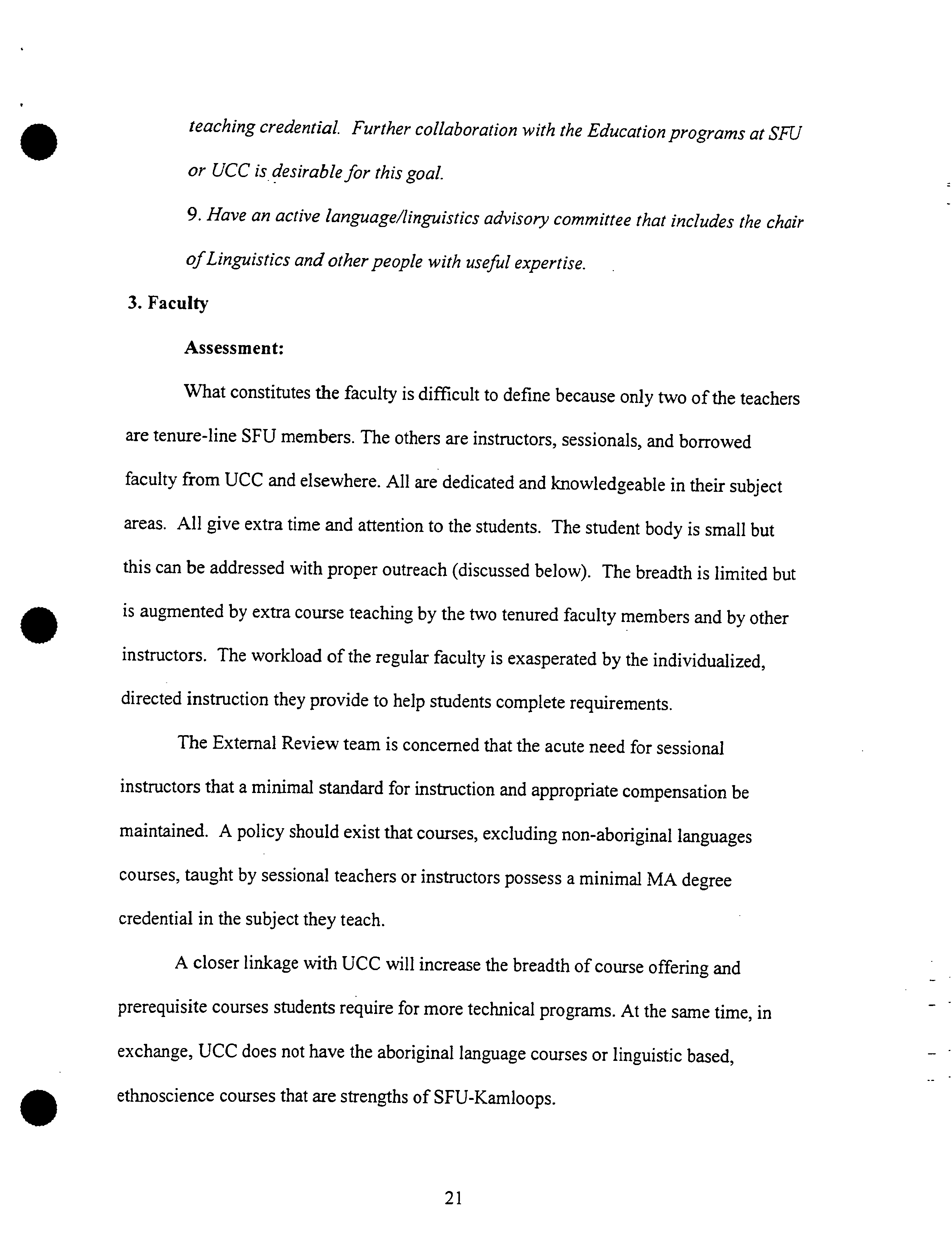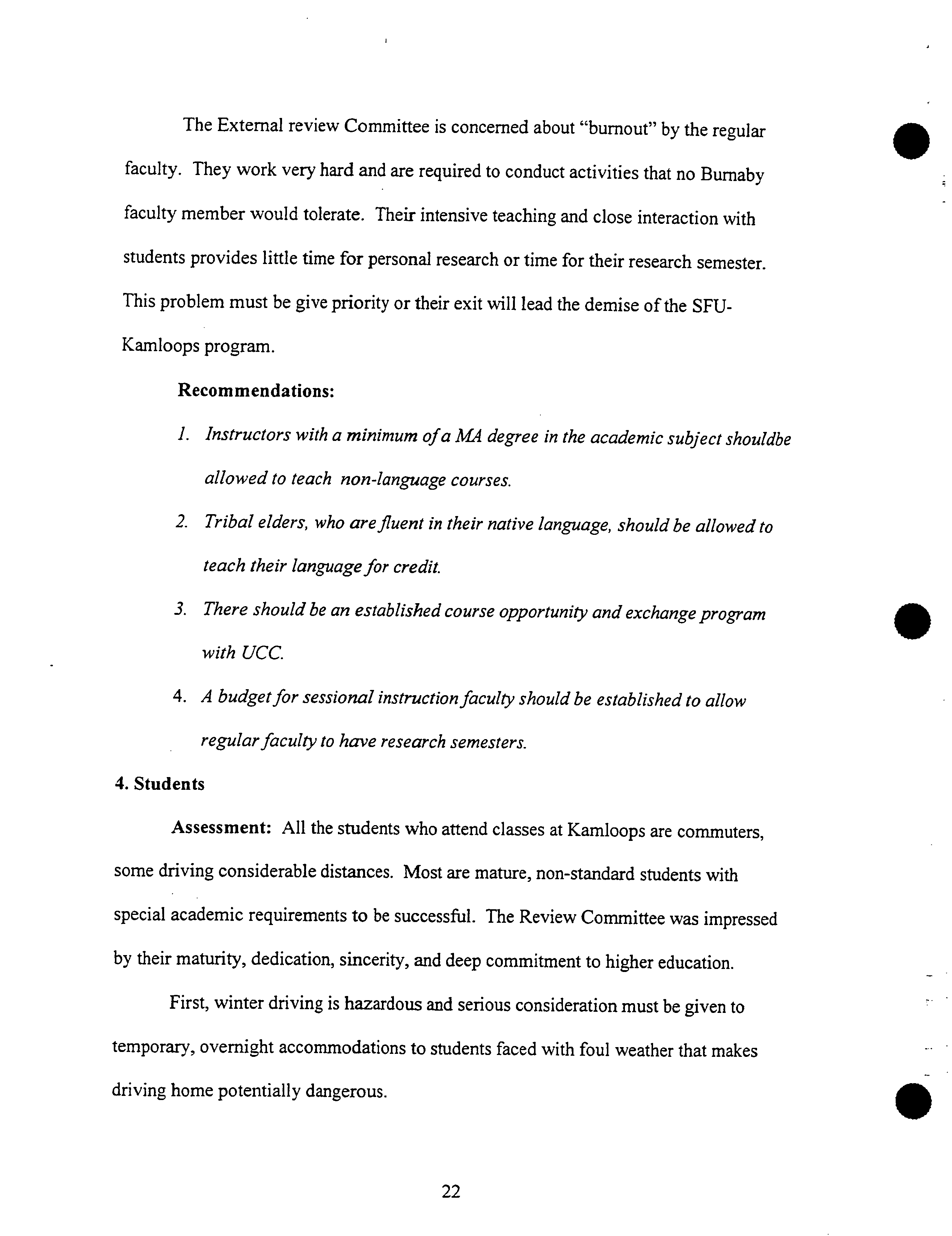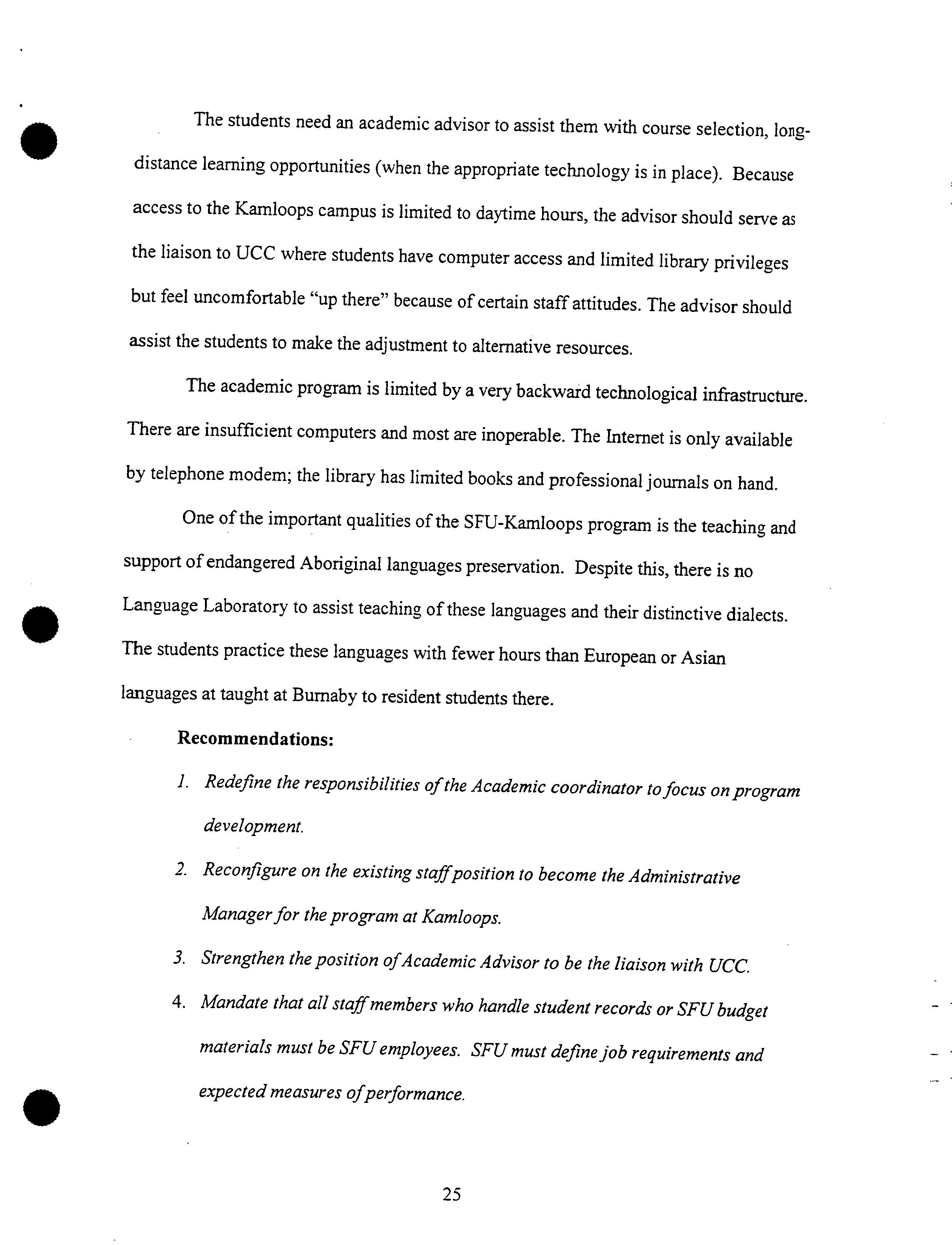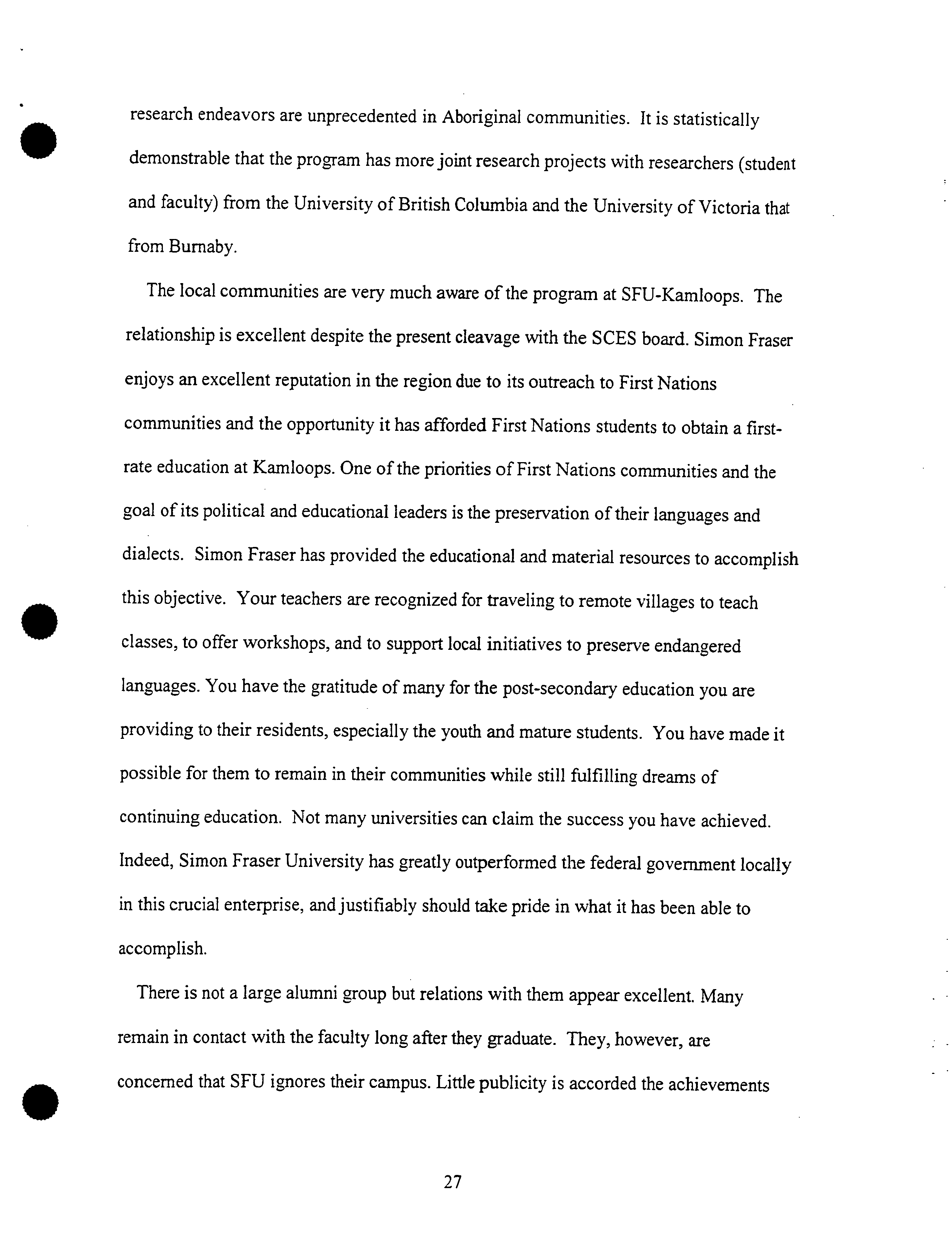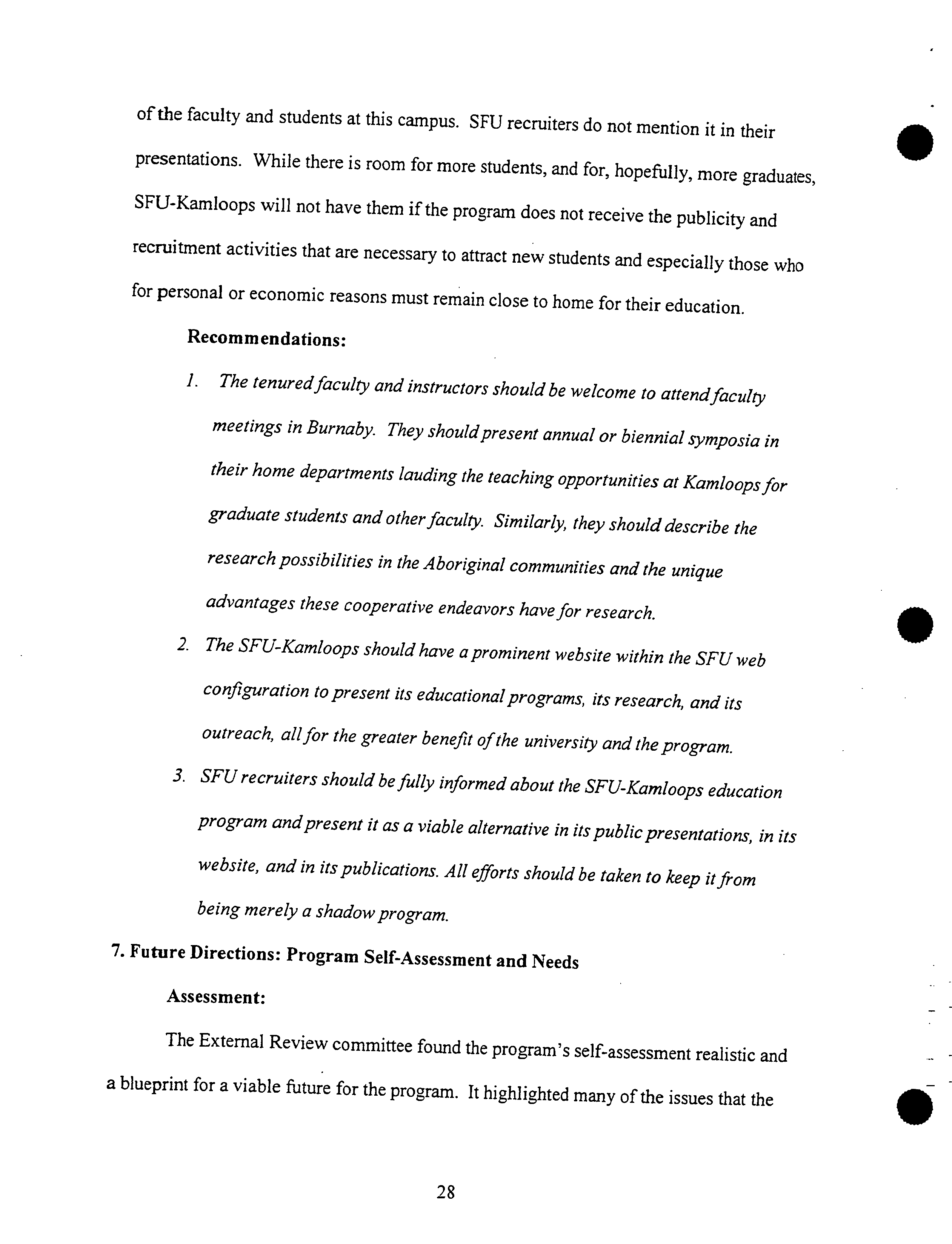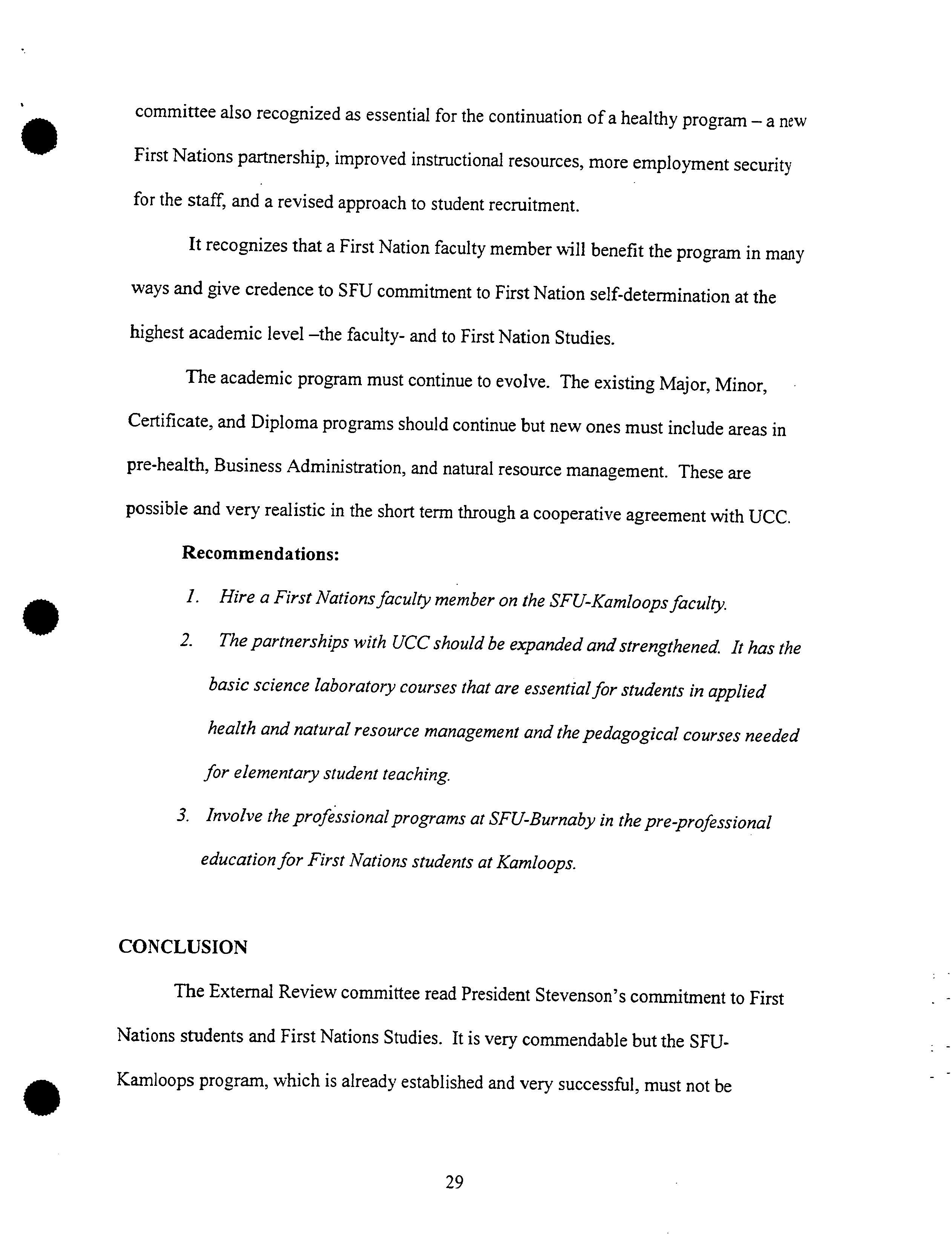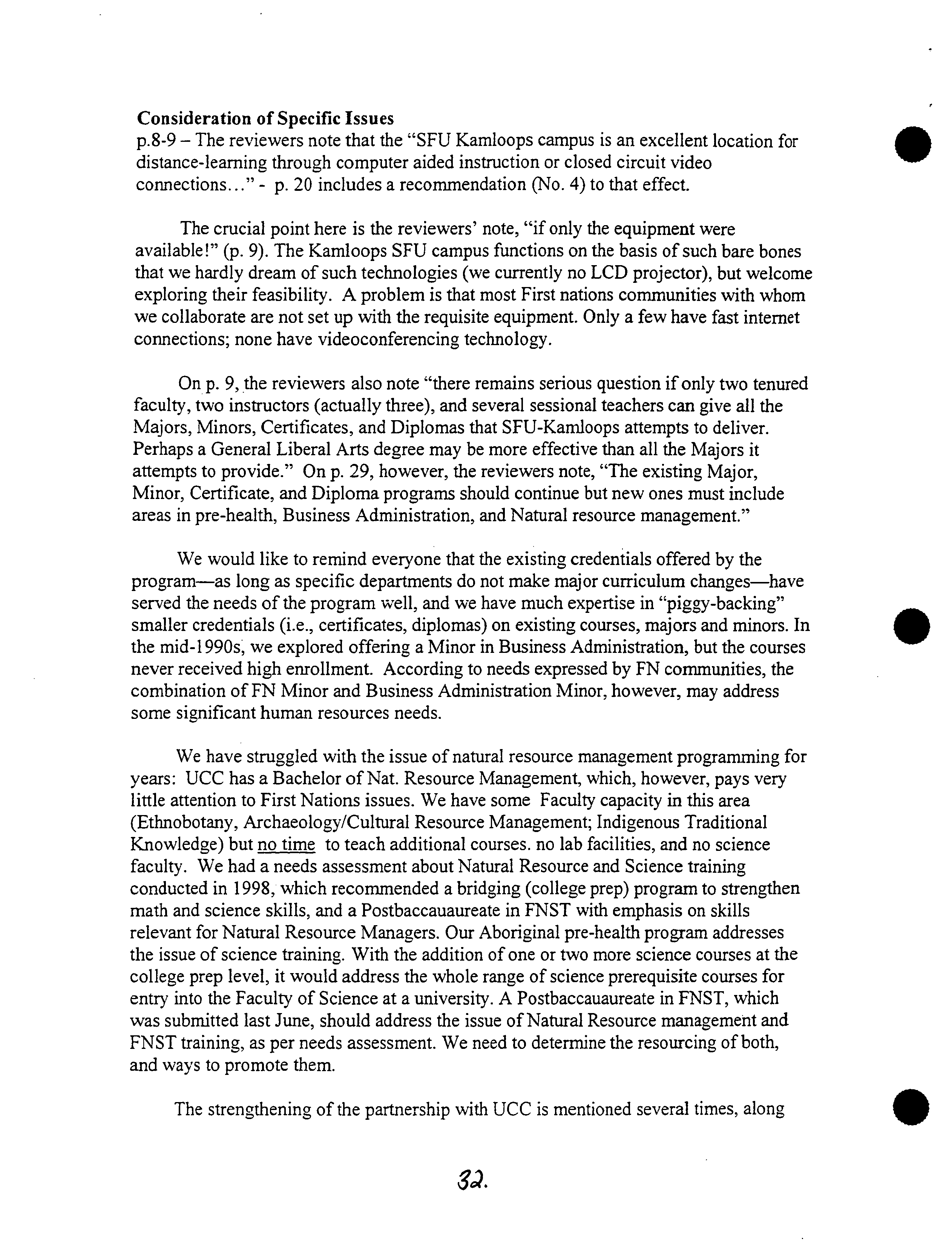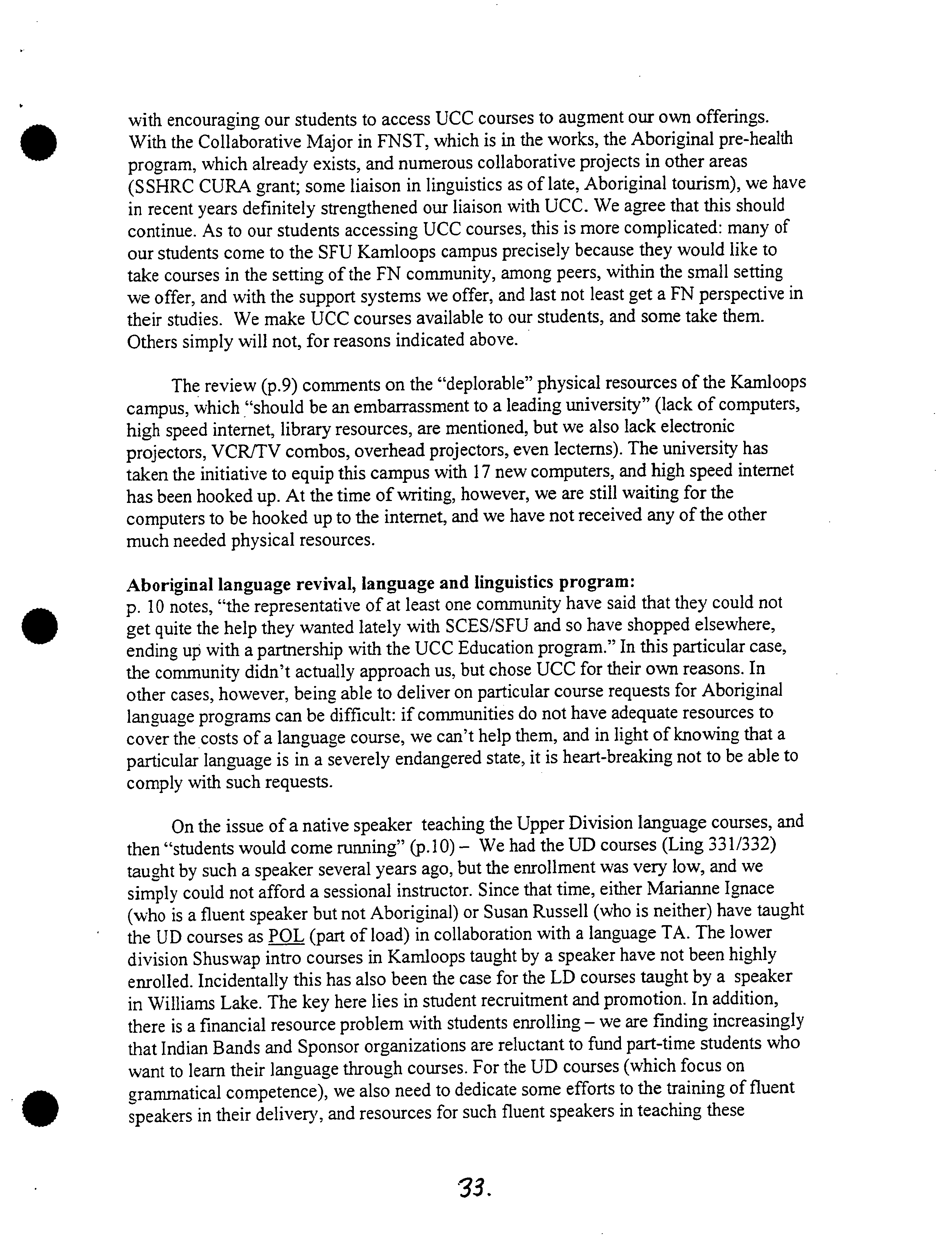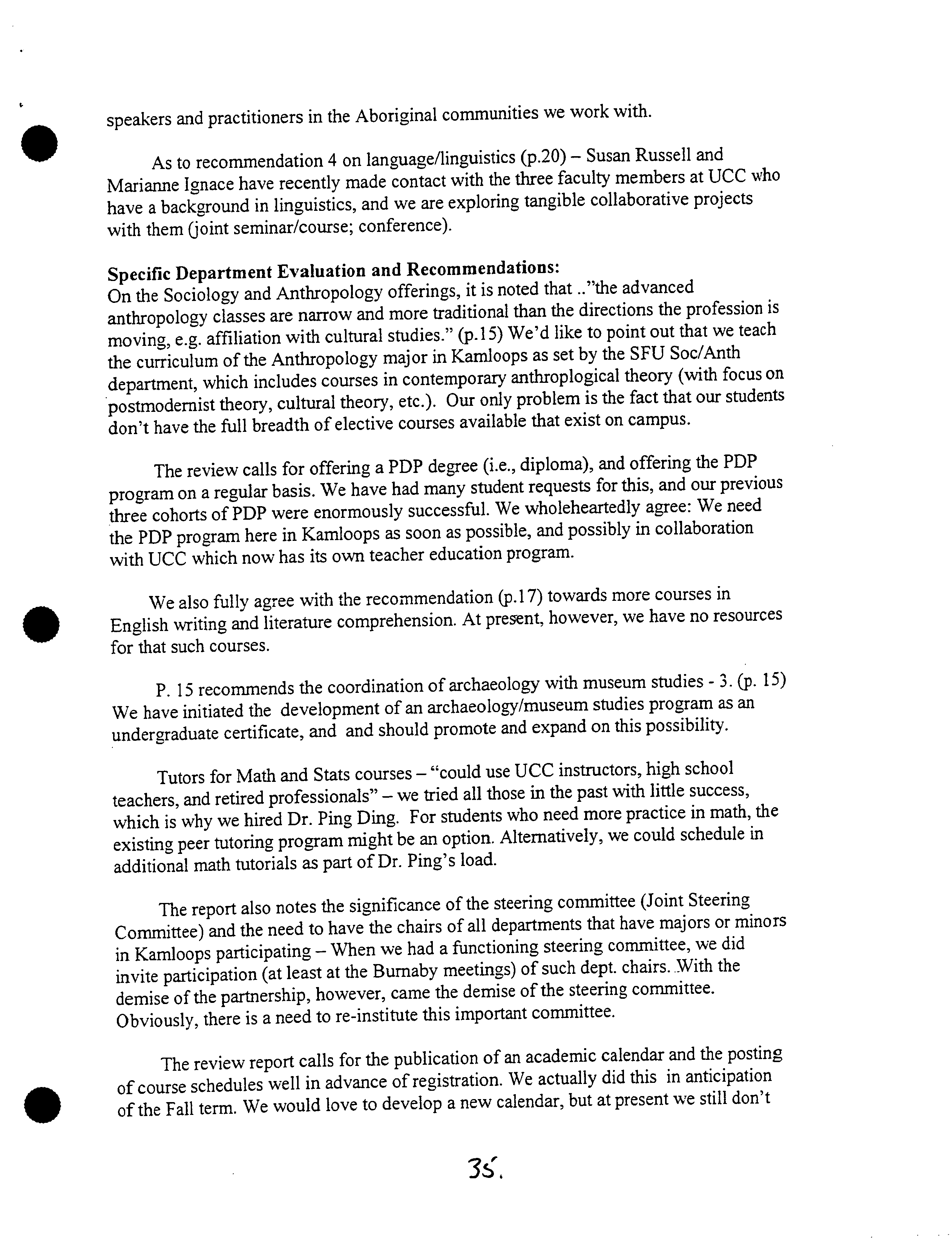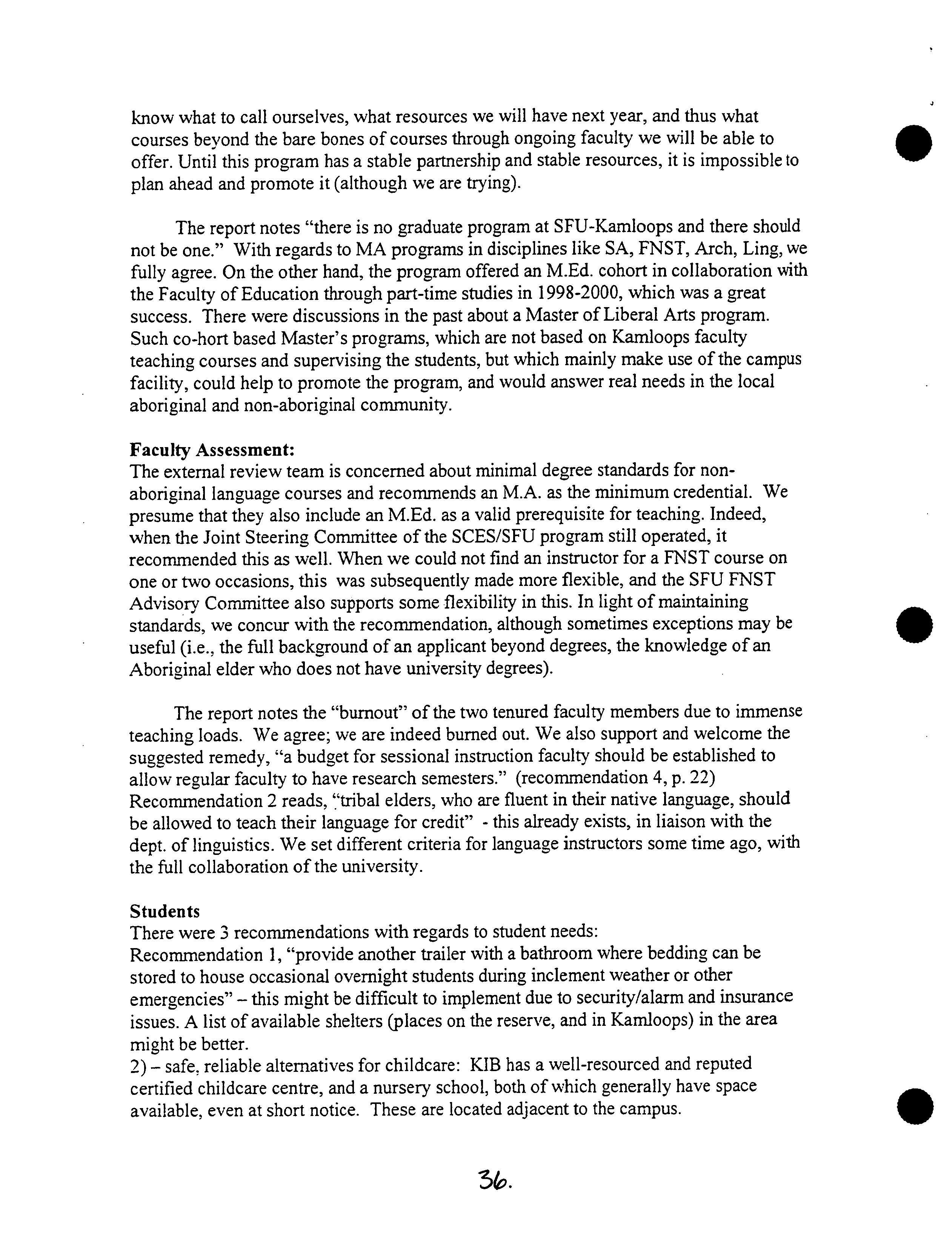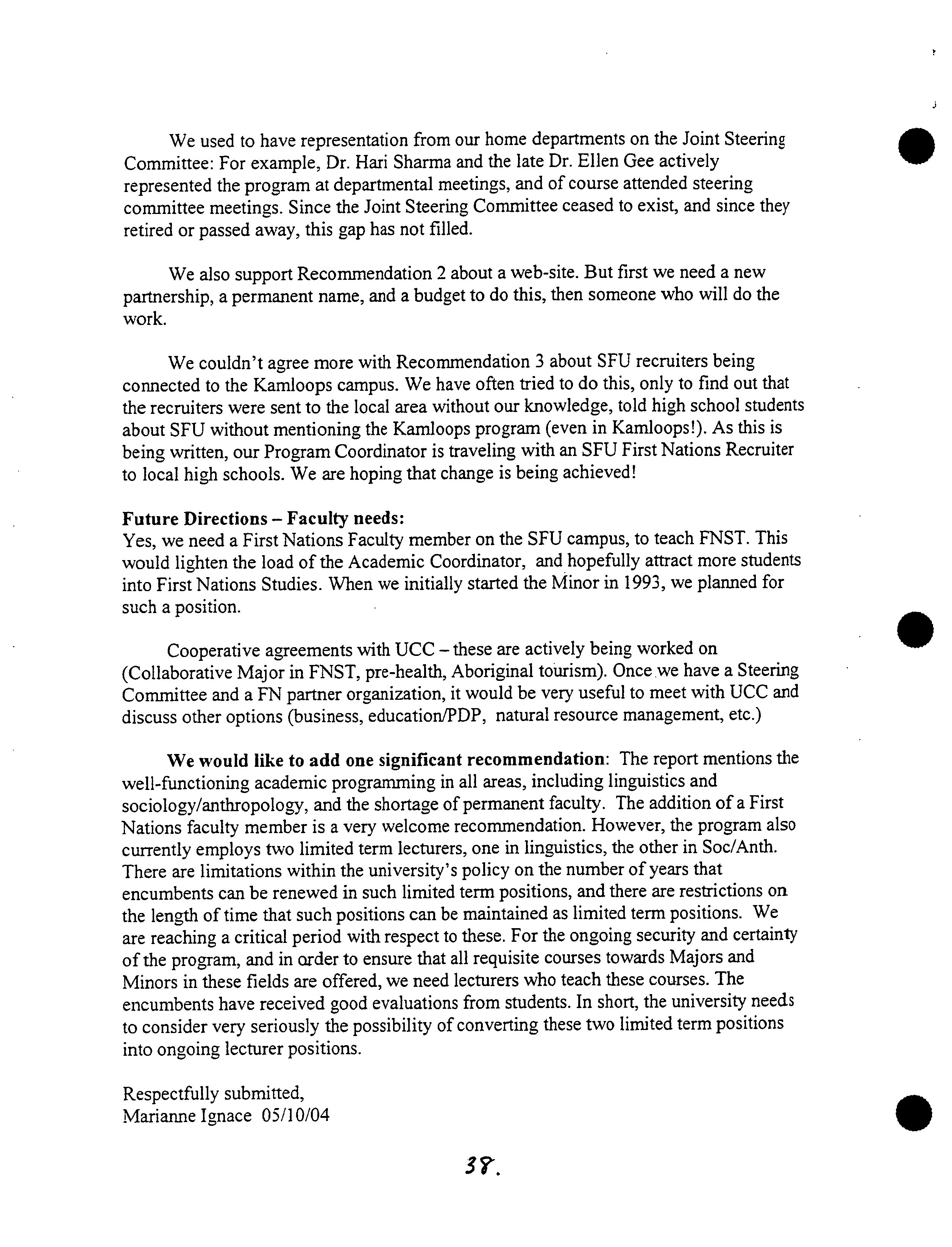
S.05-8
V
SIMON FRASER UNIVERSITY
Senate Committee on University Priorities ?
Memorandum
TO:
Senate ?
FROM:
John Wate ?
Chair;
RE:
SFU Program at Kamloops ?
DATE: December ?
(formerly SCES/SFU Program)
.
S
The Senate Committee on University Priorities (SOUP) has reviewed the
External Review Report on the Secwepemc Cultural Education Society SFU
Program at Kamloops (SCES/SFU), together with a response from the Academic
Coordinator of the Program, the Dean of Arts and Social Sciences and input from
the Associate Vice-President, Academic.
Motion:
That Senate concur with the recommendations from the Senate
Committee on University Priorities concerning advice to the Simon Fraser
University Program at Kamloops (formerly the SCES/SFU Partnership)
on priority items resulting from the external review.
The report of the External Review Committee for the SCES/SFU Program was
submitted on August 2, 2004 following the review site visit which took place April
21-23, 2004. The response of the Department Chair was received on October 5,
2004 followed by that Of the Dean of Arts and Social Sciences on October 22,
2004. On September 23, 2004, SCES and SFU formally terminated their
partnership, and SFU is currently pursuing the establishment of a First Nations
partnership with the Kamloops Indian Band, on whose reserve land the SFU
Kamloops program is situated.
SCUP recommends to Senate that the SFU Program at Kamloops and the Dean
of Arts and Social Sciences be advised to pursue the following as priority items:
ACADEMIC PLANNING
SOUP recommends that the Program and the Dean develop an Academic Plan
for SFU's interest in Kamloops covering the period 2004 - 2007. The Plan should
include the following:
1.1 ?
Faculty & Staff:
•:• A determination of the levels, qualifications and departmental
affiliations of faculty required to meet the demand for the programs
planned at the expected enrollment levels
• ?
Consideration regarding the need for tutors, sessional instructors
and the use of experts from SFU and the Thompson Rivers
University
•. A review of the positions, roles and tasks of Academic
Coordinator, Administrative Assistant in Burnaby, and Program
Coordinator and auxiliary staff in Kamloops
•. Consideration regarding the hiring of a First Nations faculty member
1.2
?
Programming:
•. Consideration of joint programming with Thompson River
University in areas beyond the curricula and programs where joint
programming and collaboration is already taking place.
•:
?
Consideration regarding the introduction of additional English
writing and comprehension courses
•:• ?
Consideration regarding the introduction of additional Professional
Development Programs for teacher training
1.3 ?
Enrollment:
•• Development of enrollment targets for the next three years and a
recruitment plan to suit.
2 ?
FACILITIES PLANNING
SCUP appreciates the importance of providing facilities that reflect the
importance of the activity in Kamloops and recommends that the Program
and the Dean urgently address the following;
• To develop a plan, for SCUP's approval, to move or upgrade the
current facilities to something more reflective of an SFU activity,
over the next 2 or 3 yrs.
•• To ensure in the immediate future that internet and computer
facilities, as well as instructional media equipment, are equivalent to
those offered at other SFU campuses.
•• To explore new opportunities for sharing the Thompson River
University library facilities, and to explore improved student, faculty
and staff access to the SFU library through the internet.
0
0
?
3 MONITORING
In the event that a formal partnership is established with the local First
Nations in Kamloops in early 2005, SCUP recommends that the university
actively engages the First Nations partner in advice and recommendations
towards this planning process.
SOUP requires that these issues be urgently addressed and a report be
made to SCUP together with a copy of the Academic Plan and the
Facilities Plan by or before March 31, 2005.
.
3
SFU Academic Report
EXTERNAL REVIEW OF THE ACADEMIC PROGRAM OF THE
SECWEPEMC CULTURAL EDUCATION SOCIETY-
SIMON FRASER UNIVERSITY-KAMLOOPS
Submitted By: Dr. Richard I. Ford (University of Michigan)
Dr. Roland Chrisjohn (St. Thomas University)
Dr. Leanne Hinton (University of California, Berkeley)
EXECUTIVE SUMMARY
The Secwepemc-Simon Fraser-Kamloops cooperative education experiment has been
highly successful and continues to be a vital program in the lives of First Nations
students and others for whom a college education based upon community needs would
otherwise be unavailable. Although there are presently administrative problems with the
contract for cooperation, the program has academic integrity and provides a degree with
academic credibility. The language outreach has been highly successful and it continues
to be an important benefit to First Nations communities as they endeavor to preserve
their languages and dialects. The faculty and staff are dedicated to the program and to a
quality education for students, many of whom are mature students or students for whom
post-secondary education came later in life. The External Reviewers believe that
•
administrative changes are necessary to enhance the program and to get the most
efficient performance from the faculty and staff The education program will be
improved with immediate attention given to the technical infrastructure, including
working computers with memory sufficient to rum complex statistical packages, high
speed Internet connectivity, video connection for remote learning, and a Language
Laboratory for endangered language instruction and practice.
The Review Committee evaluated the specifics of the academic program. As a result of
its assessment, it has made a number of recommendations to strengthen the program, to
benefit student education, to maintain the faculty's and staff's exceptional dedication to
the program, and to increase the number of students who will benefit from it.
REVIEW PROCEDURES.
The committee believes that it is well prepared to evaluate this program. Well in
advance of our arrival in Vancouver we were provided with the Program's self study,
documents from the Simon Fraser administration, and our Terms of Reference. Our
first
meeting at the Burnaby campus acquainted us with administrative officers followed by
L
meetings with the relevant department chairs. One Kamloops faculty member met us at
Burnaby.
Our agenda in Kamloops was very full but extremely comprehensive. We met
with the faculty, the student society, alumni, graduate students, and faculty from the
University College of Cariboo, Kamloops Indian Band officers, and interested
community members. A special meeting was arranged with board members of SCES.
Since a major contribution of the SCES program is endangered language outreach
and teaching these languages, we made a site visit to one of the collaborative programs in
Lillooet. Conference telephone calls were conducted by a subset of our review committee
with language participants in four other communities. (It was necessary to divide the
committee into two sub-committees in order to interview and give adequate time to all
the stakeholders who wanted to meet with us.) Both sub-committees accomplished these
objectives within the allotted time. Although we are certain that some groups would have
wanted additional time with us and we with them, we did depart Kamloops with a very
comprehensive appreciation for the strengths and weaknesses of the program.
When we returned to Burnaby, we recognized that we had not requested while in
Kamloops copies of all recently offered course outlines. The office staff in Burnaby
proved us with copies that it had on hand and requested the Kamloops office to fax the
missing outlines. All did this graciously and expeditiously. These we reviewed in detail
on our final meeting together on Saturday.
The single item we did not request was course evaluations. We did ask questions
about procedures for evaluations and anecdotal comments about courses, but quantitative
data were not requested. This was an oversight by a very busy committee.
?
0
.
??
Our final meeting with the Simon Fraser administration resulted in the procedures
for our report and a tentative timeline. Facilities and resources made available to us at
the downtown campus of SFU on Saturday, April 17, enabled us to meet to peruse the
course outlines, discuss their contents, outline our responses to questions on our charge,
and assign responsibilities for completing the academic report. Since this is a committee
report, plans were made for the iterations for commentary and approval before a final
report would be submitted. The chair (Ford) would be responsible for the initial draft; its
circulation to committee members and our Simon Fraser faculty liaison, Dr. Zita
McRobbie, who became our indispensable colleague and tutor to the "culture" and
academic procedures at Simon Fraser; and final editing.
. ?
GENERAL OVERVIEW
The Terms of Reference contain many overlapping objectives and inquiries. We
interpreted them as nested from general evaluation to specific details.
The Secwepemc Cultural Education Society (SCES) and Simon Fraser University
(SFU) cooperative academic program is very unique and highly successful. It is one that
should be a source of pride by both principle parties. It is rare that a First Nations
community initiates a comprehensive educational program and finds a premier university
partner that does not dominate the relationship. This is a very long-standing program that
does deserve periodic academic evaluation and review of the enabling contractual
partnership and its performance.
SFU has provided an academic program to educate students that might otherwise
never experience a college course. SFU, to its enduring credit, allows admission of
students with weaker academic credentials than are found at Burnaby, mature students,
and students with complicated domestic situations, which prevents them from traveling
far from home for a post-secondary education. These are students who earned a second
opportunity to attempt higher education. As one student told the review committee, "I
never thought seriously about education, no less college, until later in life when I realized
what I was missing." SFU gave this student and others like her an opportunity to amend
their past. These students are very successful by any measure - graduation, academic
enthusiasm, citizenship, and service to the community. SFU should be very proud of its
academic side of the compact.
The partnership has lapsed and is not in effect.
It needs to be reconstituted with a
revised agreement and possibly a new partner. No matter, the review committee
recommends that the driving force behind this educational program remain the First
Nations communities and people. Their aspirations must be accorded priority as SFU
attempts, if possible, to accommodate them. It has done so successfully in the past and
present, and should have similar results in the future.
The quality of the teaching program is high, innovative, and under constant
internal re-evaluation.
The teaching staff (defined below) is dedicated, skillful, and
adaptable under the circumstances in which they teach. The faculty offer core courses and
the program contracts with qualified sessional faculty to provide additional courses to
assure program and degree breadth. The academic program is determined by SFU
graduation requirements, by SCES community desires, by student interests, and by the
core faculty's assessment of student educational needs.
1]
4
Faculty research, collaboration, and academic environment are emphasized
but strained
by
demographics.
Tenure-track faculty has exceptional research records.
However, with only two faculty members collaboration is informal but not together on
research projects. The academic research environment includes students and some
colleagues at Burnaby but also at other institutions. The successful research activities at
Kamloops demand off-campus collaboration and contacts because the resident faculty
size is limited.
Department Governance and Dissemination of Knowledge.
The governance of
this program is two headed. One is the participation by the faculty and instructors. They
are sufficiently few in number that almost daily conversations are conducted about the
program. All feel that they are listened to and their opinions are respected. In addition,
the faculty actively solicits community and student ideas about the program and courses
needed. This is a very egalitarian method of governance. The second is the Steering
Committee that is a joint administrative structure over the program. It is very important,
in fact critical to the success of the program, but must be strengthened.
The program receives the highest commendation for dissemination of
knowledge.
First, it offers academic courses away from Kamloops. Second, it has a
network of Province wide linguistic/language instruction and interaction with community
language programs. It gets high marks from community leaders and this program should
be received with gratitude by SFU as an important part of its commitment to First
Nations communities where preservation of endangered languages has their highest
priority. The aboriginal languages of B.C. are all critically endangered, and without
extreme measures they will have no native speakers left at all within the lifetime of
current SCES/SFU students. Communities whose languages these are have not
voluntarily lost their languages -- it has happened through a combination of factors,
including past government policies intended to eradicate them and the current domination
of English in all walks of life. Communities all over B.C. are trying their very best to
reverse the trend through documentation, language teaching, and anything else they can
do to keep their languages alive. Given this, the
l
anguage/linguistics program at
SCES/SFU is unique and invaluable. It includes on-campus courses in aboriginal
languages and linguistics, and an outreach program to communities all over B.C. SFU is
getting much-deserved gratitude from numerous aboriginal communities for helping them
keep their endangered languages alive. Third, the faculty publishes widely for
community, student, and professional audiences.
Environment Conducive for the Attainment of Department's Objectives. We
cannot provide a full assurance to this review query for two reasons. First, student
education is the primary objective of the faculty but the infrastructure for adequate
learning is deficient, as we will describe later in the review. Second, the interference in
the academic program and staff relations by the SCES board has created a Situation that
limits all employees from devoting full attention to their employment obligations. These
tensions must be addressed before the faculty and staff can fulfill their goals for
providing a quality education.
Many points in this overview will be clarified and amplified in the remainder of
the report.
CONSIDERATION OF SPECIFIC ISSUES
Six issues were highlighted in the Terms of Reference for in depth review. We examined
each in detail and our evaluation of some is unusually lengthy.
Evaluation of the Administrative and Academic Future of SFU-SCES Partnership.
Tensions have been mounting at the Kamloops campus between Simon Fraser University
and its partner, the Secwepemc Cultural Education Society (SCES). The contract with
SCES has expired; SCES claims that it is continuing. Even before that, communications
between SCES and SFU-Kanloops have been nearly non-existent for two years. SCES
has implemented staff changes without consultation with the academic director or other
SFU personnel. SCES has created a Task Force, which is drawing up a new agreement
with no consultation with SFU. It purportedly plans to this present to SFU as a fait
accompli.
SFU should pursue proper bilateral negotiations leading to a revised agreement
with SCES or, failing a successful outcome, a new relationship with another partner,
possibly the Kamloops Indian Band, as an interim solution. We believe an outstanding
strength of the SCES-SFU program has been the First Nations initiative to create this
unique educational opportunity and that active First Nations participation should serve as
a main principle as you renew your partnership or develop a new one. If a new partner is
required, an initial agreement might be fashioned on an interim basis until details of a
long-term arrangement are developed. If necessary, reconfigure a Steering Committee
without SCES participation but with new Secwepemc aboriginal members. Increase the
oversight by the Steering Committee in the Kamloops institution and its renewal.
.
VA
Past success of the Program signals a promising future. SFU must continue to
?
0
expect the highest standards of academic excellence for the students and provide the staff,
partnerships, and infrastructure to achieve them. Certainly the Aboriginal communities,
students, and faculty expect no less from any future partnership.
Evaluation of the Success of the Program to Provide Academic Courses and
Credentials.
The program has been and continues to be successful according to all
academic and community criteria that the Review Committee applied. Its graduates for
the most part have the background and skills to go on to graduate school with success.
Others have obtained teaching positions in their home communities. Still others have
become council members in First Nations government. All are good citizens. The
program has provided the social research skills in sociology and anthropology to be
useful to their home communities. An examination of the statistical syllabus reveals that
they have a strong academic program with the major handicap being inadequate and
unreliable computer resources (more later). The cultural resource management (CRIvI)
instruction is excellent. The Kamloops archaeological field school enjoys an
international reputation. By learning archaeological techniques through participation on
the field school and then continuing their "apprenticeship" by working on research
projects with Professor Nicholas or applying their skills on salvage projects, they have
the basic background to conduct independent CRM work. The Aboriginal language
program has years of success to commend it and it has spawned independent programs
based upon local teachers who learned their skills through the SFU-Kamloops faculty.
The SFU-Kamloops campus is an excellent location for long-distance learning
through computer aided instruction or closed circuit video connections. There are many
0
8
. ?
courses at Burnaby that can provide this academic breadth to the students
"thirsty for
knowledge" in Kamloops, if only the equipment were available!
There remains serious question if only two tenured faculty, two instructors, and
several sessional teachers can give all the Majors, Minors, Certificates, and Diplomas that
SFU-Kamloops attempts to deliver. Perhaps a General Liberal Arts degree may be more
effective than all the Majors it attempts to provide.
Evaluation of Faculty, Staff and Physical Resources.
The quality and
dedication of the faculty (all categories) and staff are exceptional. Their commitment to
the program, even under adverse circumstances, is what enables it to continue at a high
academic level of education and research accomplishment. The physical resources are a
separate issue.
In afew words, they a deplorable and should be an embarrassment to a
•
?
?
leading university.
The computers do not function, high speed Internet is absent,
Burnaby-level library resources via electronic connectivity are lacking, and access to
remote learning by teleconferencing is unavailable.
Evaluation of the Program is Addressing Aboriginal Language Revival.
We are very happy to see that the SCES/SFU program is utilizing immersion
methods of language teaching, TPR, and other state-of-the-art language teaching
methods. The language mentoring classes, where students work one-on-one with
speakers to develop conversational proficiency, is well-planned and very popular with the
students. SCES/SFU is also working with communities all over the province on language
planning, curriculum development and proficiency development. We spoke to people
from about 10 communities, and the general impression we got was great excitement
0
about their language revitalization programs, and a sense of confidence coming out of
good training and other forms of SFU assistance.
Representatives of at least one community have said that they could not get quite
the kind of help they wanted lately with SCES/SFU, and so have shopped elsewhere,
ending up with a partnership with the UCC Education program. We consider this good --
there is no reason why the SCES/SFU program has to do all the training, and in fact it is
stretched too thin (further discussion on this below); so broadening the support base for
the languages can only be helpful. It would be useful for the SCES/SFU faculty to meet
with
the people at UCC
who
are doing this work if they have not already done so, and
develop good communication and cooperative ventures. Relationships such as this can
blossom into increasing effectiveness in helpin
g
the aboriginal communities in their
efforts to keep their languages alive.
Some students at SCES/SFU take courses in their own heritage languages to
develop both linguistic knowledge and conversational proficiency. A number of the
students opt to take the 4 courses that lead to obtaining a Language Proficiency
Certificate. However, although many students at Kamloops take the lower-level
language courses, only a few take the higher level courses that lead to getting the
certificate. Some of this is because of tensions over a non-native person teaching the
higher level courses. Several students told us that if the native speaker
who
teaches at the
lower levels would be able to teach the higher-level classes too, they would come
running. The Kamloops teaching staff is aware of this problem and would like to have
more native speakers working in the program. However, native knowledge of a language
is not the same thing as having knowledge of how to teach a language. What is needed is
0
10
advanced teacher training and mentoring to help native speakers develop course curricula
and teaching methods for all levels of language teaching.
There is only one staff person, a limited term lecturer, who focuses full time on
teaching language and linguistics. The contributions from this position are just as
invaluable to the program as those of the two tenured faculty members and consideration
should be given to converting it to a permanent lectureship.
The faculty teach far more than their job descriptions demand of them. They see
the great and diverse needs of the communities and try to respond to them, but they
cannot do it all. Sometimes their travel to the outlying communities to teach there
disrupts their teaching at Kamloops, which is very bad for the program. While their
dedication is truly admirable and their ability to accomplish so much is astounding, the
• quality of their accomplishments could only improve if they could learn to say "no"
sometimes, and/or plan for ways to lessen their travel and time commitment. Some
suggestions relating to linguistics and language teaching are these:
• Limit the times they teach courses in outlying communities to summer
months so that they will not be missing classes at Kamloops or traveling
dangerous roads in icy weather;
• Hold more intensive two-week courses in Kamloops that people from
various communities could attend. This would include such courses as
language teaching methods, curriculum development, etc. and could be
planned to lessen the amount of time the staff spends traveling out to the
communities;
.
11
• Work toward increased training of native speakers in language teaching
methods and curriculum development. This last suggestion may need some
administrative and financial backing -- for example, travel expenses and
conference expenses for elders who are teaching in the Kamloops program or
in SFU-sponsored courses in the outlying communities would be of great help.
• Work toward computer or television methods of course delivery. (This is
not to suggest that the face-to-face component would disappear; certainly site
visits would remain important, but lesser in number)
• Keep on working to an increasingly large "stable" of experts from UCC,
SFU and elsewhere that can be called upon to help communities with
language revitalization.
The language mentoring courses and other conversational courses need more
hours per week, if not in actual class time with an instructor, then in lab or in
conversation with speakers.
5-6
hours per week is standard for a language class.
Presently the language courses do not have enough hours per week of language exposure
for effective language learning. For the mentoring classes, there should be
6
hours per
week of interaction between the mentor and student rather than
3.
For the regular
language classes, there could be hours assigned without the teacher, of group
conversation practice, possibly led by a teaching assistant. One question in the self-
report (Section 6.7) was how fluency best can be achieved in face of the challenges
particular to endangered languages. No-one has a firm answer to this question.
However, key to language revitalization is the redevelopment of language
use
(which is
not guaranteed by language learning). The more assignments there are that are oriented
0
12
toward getting the students to use the target language with each other and with elders and
other people outside the classroom, the better it is for both language learning and the
rebirth of language use. The availability of a Language Laboratory would be another
way to assist accomplishment of this goal. (Since we did not get to attend any language
classes, we don't know if that is already a strong focus of the coursework
Evaluation of how well the Current Academic Disciplines meet the needs of
First Nations Communities and Need for New Programs.
There are needs that have
not been met recently and new opportunities that should be added. More permanent
courses related to writing and literary comprehension should be standard. There is a
crying desire for teacher training through the PDP program. The SFU-Kamloops
academic program does not have standard laboratory science courses. These can be
. ?
arranged through partnership with University College of Cariboo (UCC). Here a
complimentary strength already exists. While the communities want more students
trained in natural resource management, SFU-Kamloops and its strong language program
offer unique courses in ethnoscience - ethnobotany, ethnobiology - that UCC does not
but that must be part of Aboriginal resource programs. Similarly, the call for more health
sciences - nursing and public health - have the same complementary relationship - the
basic sciences can be obtained at UCC and the ethnomedicine obtained through SFU
courses.
Evaluation of Satellite Program Issues.
Isolation from "home" academic
departments at Burnaby is a relative issue because it can be improved through a more
efficient Internet connection for faculty and students. More frequent face-to-face contact
9
?
with department colleagues and other graduate students should be encouraged and will be
1-
1.)
improved
if
there is better knowledge in Burnaby about the Kamloops teaching and
research opportunities.
Graduate students recognize that they will have to assume some residence in
Burnaby but otherwise will carpool with others at least weekly to Burnaby. Kamloops
graduate students are not part of the Archaeology or First Nations departments graduate
communities and this is unfortunate for their education. Again, electronic newsletters
from the academic departments and e-mail keep students in partial contact with other
students and faculty. Despite these favorable comments, there is still stress and
individual adaptability is necessary to maintain a successful graduate education.
SPECIFIC DEPARTMENT EVALUATION
I. Programs
Assessment:
The SFU-Kamloops program follows degree requirements for the University's
undergraduate program. The basic, core courses in the social sciences, including
Archaeology, Linguistics, and Mathematics are very solid. A review of the course
outlines supports this conclusion.
The Majors, Minors, Certificates, and Diplomas are a reasonable mix of
opportunities to meet the First Nations communities' needs in the targeted academic
areas.
Math and Statistics courses are particularly impressive. If the students actually
understand and can apply what is offered in these courses, they constitute a unique and
powerful accomplishment for faculty and students alike. Since this level of instruction
14
•
??
may well be beyond the background of many students, a tutor system should be in place
?
to assist them.
Archaeology and Summer Field School. These are excellent courses and a world-
renown field program is available to all students.
The archaeology program should be coordinated with Museum Studies since
artifact curation, conservation, and presentation are critical issue in archaeology today.
Sociology and Anthropology (Introductory) are solid and what you would expect
at any major university. The Anthropology course does include worldwide cultural
comparisons. However, the advanced anthropology classes are narrow and more
traditional than the directions the profession is moving, e.g., affiliation with Cultural
Studies.
• ?
Linguistics. This should be changed with an emphasis on Language learning and
instruction. The Secwepemc language instruction does give good language structure and
vocabulary but not frequent conversation. The students need time to learn the language,
more practice speaking the language and a Language Laboratory to assist them to
accomplish language learning.
Ethnobotany and Ethnoscience. These courses give the program a particular
distinction complementary to biological science course taught at UCC. They are
excellent and very exciting to the students.
Additional breadth is needed in several areas. There is a need for more English
writing and literature comprehension courses. There should be a recognized relationship
with UCC to offer courses that are too expensive, e.g., laboratory courses, to be offered al
•
15
In addition to stronger ties with UCC, more attention should be given to distance
0
learning options from Burnaby.
Teacher training is a particularly important part of the Kamloops program that has
lapsed
in
priority. The 12-month teacher education PDP degree was very popular
between
1995
and 2000. The communities and students desire continuation of the PDP
but considerable time has expired since it was last offered. A
PDP
degree should be
offered.
The Steering Committee should work with the Academic Coordinator early in the
previous academic year to organize the course schedule in sufficient time for the students
to know before registration what courses will be offered in a particular term. The Steering
Committee should include the Chairs of all academic departments that offer majors and
minors at Kamloops. Academic oversight from the main campus should be strengthened.
Course evaluations should be regularized and strengthen with in-class visitation of
all teachers and required evaluations of all courses, including visitors. As part of the
course evaluation review, the grades awarded in the classes should be reviewed to assure
that all teachers follow consistent institutional standards since so many visitors provide
courses as part of this program.
There is no graduate program at SFU-Kamloops and there should not be one.
There is simply insufficient faculty at Kamloops to offer a credible graduate program.
Qualified students should do as has become standard practice: apply to Burnaby, work
with a Kamloops faculty member as an adviser but take additional courses from other
faculty at Burnaby, remain integrated with the Burnaby academic departments through e-
mail electronic newsletters, announcements, etc.
?
0
16
• ?
Recommendations:
I. Broaden the academic program with courses from UCC.
2.
Give attention to the needfor English writing and literature comprehension
courses.
3.
Chairs ofAcademic Department that give Majors and Minors at Kamloops
should be included on the Steering Committee
4.
Add regular sessions of PDP for teacher training certification and a PDP
degree.
5.
Need tutors for Mathematics and Statistics. Could use UCC instructors, high
schoolteachers, and retired professionals.
6 Publish the calendar of courses well before the enrollment period begins.
•
?
7. Require evaluations of all courses and in-class visits of all non-tenured
teachers in the program.
8. There should not be a graduate program at Kamloops at this time. Burnaby
students should be encouraged to work with SF U-Kamloops faculty.
2.
Language Instruction
Possibility of a new applied linguistics major or emphasis in "The teaching and
preservation of endangered languages."
Assessment:
There is tension between SFU definition of "Linguistics" and the needs and
desires of aboriginal communities, which is for language proficiency, language learning
and teaching theory, language teaching methods, and materials and curriculum
0 ?
development.
17
The change in designation of the language courses is reasonable -- the chair of the
Linguistics department has asked that the mentoring courses and the other courses where
learning the language is the primary goal all be called Language courses rather than
Linguistics courses. In support of this, one alumnus said that sometimes students are
"forced" into Linguistics majors because in order to learn their heritage language they
took so many linguistics courses that in the end that is the only reasonable choice for a
major. Yet most of the courses are actually language courses, and therefore do not give
adequate preparation in linguistics for a Linguistics major.
What the communities really want is to (a) learn their endangered languages of
heritage: and (b) learn how to teach their language to others. Documentation and
archiving of language data, recordings and materials would also be useful to them. To
this end, what would be ideal is the design of a new applied linguistics major in "The
teaching and preservation of endangered languages," which would include introductory
linguistics and phonetics , courses in language pedagogy, the collection and archiving of
language and traditional knowledge, and development of language proficiency. Most if
not all these courses are already taught; it is just a matter of putting together a sequence
that is officially designated as a new major or emphasis.
There are also courses taught at the SFU campus which would be of great benefit
to the Kamloops students: for example, the courses on Endangered Languages, and
Languages of the World. If courses such as these could be made available via television
to the Kamloops campus, that would be exceedingly beneficial and strengthen the
academic program.
S
18
•
??
Beyond a certificate in language proficiency, students at Kamloops and in the
outlying communities also wish strongly for courses leading toward language teaching
certificates and ultimately teaching credential. The Kamloops group has been working
toward that end. Further collaboration with the Education program at SFU or at UCC is
desirable.
Innovative courses offered at Burnaby should be exported to Kamloops. The
students in Kamloops have found the Computer Assisted Language Learning (CALL)
course extremely useful (offered two years ago, taught by a Linguistics graduate
students). It is very disappointing when courses are offered once and then never again.
The language/linguistics programs at SCES/SFU Kamloops need some close
attention from more people than just the present staff. Many of the things they are doing
• ?
now and many of the things we suggest here take more detailed and long-range planning
than the program is now capable of doing. We recommend that the language program
have a strong overseeing committee that includes the chair of Linguistics and other
people with good knowledge of linguistics and/or language teaching, who will work with
the current faculty on the further improvement of the language and linguistics curriculum
and to work together to develop the proposed new emphasis or major in the teaching and
preservation of endangered languages.
Recommendations:
1.
The linguistic/language instructors might limit the times they teach courses
in outlying communities to summer months so that they will not be missing
classes at Kamloops or traveling dangerous roads in icy weather.
2.
Hold more intensive two-week courses in Kamloops that people from various
19
communities could attend This would include such courses as language
teaching methods, curriculum development, etc. and could be planned to lessen
the amount of time the staff spends traveling out to the communities.
3. Work toward increased training of native speakers in language teaching
methods and curriculum development, through advanced teacher training and
mentoring. This may need some administrative andfinancial backing --for
example, travel expenses and conference expenses for elders who are teaching in
the Kamloops program or in SF U-sponsored courses in the outlying communities
would be ofgreat help.
4. Work toward computer or television methods of course delivery. (This is not to
suggest that the face-to-face component would disappear; certainly site visits
would remain important, but lesser in number)
5.Keep on working to an increasingly large "stable" of experts from UCC, SFU
and elsewhere that can be called upon to help communities with language
revitalization.
6. Increase the hours of the language mentoring and other conversational
courses.
7.Develop a new major or emphasis in "the teaching and preservation of
endangered languages, "which would include introductory linguistics and
phonetics, courses in language pedagogy, the collection and archiving of
language and traditional knowledge, and development of language proficiency.
8. Continue working toward goal ofprogram leading to teaching certificate and
20
•
?
teaching credential. Further collaboration with the Education programs at SFU
or UCC is desirable for this goal.
9. Have an active language/linguistics advisory committee that includes the chair
of Linguistics and other people with useful expertise.
3. Faculty
Assessment:
What constitutes the faculty is difficult to define because only two of the teachers
are tenure-line SFU members. The others are instructors, sessionals, and borrowed
faculty from UCC and elsewhere. All are dedicated and knowledgeable in their subject
areas. All give extra time and attention to the students. The student body is small but
this can be addressed with proper outreach (discussed below). The breadth is limited but
• ?
is augmented by extra course teaching by the two tenured faculty members and by other
instructors. The workload of the regular faculty is exasperated by the individualized,
directed instruction they provide to help students complete requirements.
The External Review team is concerned that the acute need for sessional
instructors that a minimal standard for instruction and appropriate compensation be
maintained. A policy should exist that courses, excluding non-aboriginal languages
courses, taught by sessional teachers or instructors possess a minimal MA degree
credential in the subject they teach.
A closer linkage with UCC will increase the breadth of course offering and
prerequisite courses students require for more technical programs. At the same time, in
? -
exchange, UCC does not have the aboriginal language courses or linguistic based,
ethrioscience courses that are strengths of SFU-Kamloops.
21
The External review Committee is concerned about "burnout" by the regular
faculty. They work very hard and are required to conduct activities that no Burnaby
faculty member would tolerate. Their intensive teaching and close interaction with
students provides little time for personal research or time for their research semester.
This problem must be give priority or their exit will lead the demise of the SFU-
Kamloops program.
Recommendations:
1.
Instructors with a minimum of a MA degree in the academic subject shouldbe
allowed to teach non-language courses.
2.
Tribal elders, who are fluent in their native language, should be allowed to
teach their language for credit.
3.
There should bean established course opportunity and exchange program
with UCC.
4.
A budget for sessional instruction faculty should be established to allow
regular faculty to have research semesters.
4. Students
Assessment:
All the students who attend classes at Kamloops are commuters,
some driving considerable distances. Most are mature, non-standard students with
special academic requirements to be successful. The Review Committee was impressed
by their maturity, dedication, sincerity, and deep commitment to higher education.
First, winter driving is hazardous and serious consideration must be given to
temporary, overnight accommodations to students faced with foul weather that makes
driving home potentially dangerous.
?
o
22
• ?
Many are parents with young children whose attendance would improve with a
facility for young children. SFU need not create a day-care center. It could be a shared
facility with Kamloops Indian Band staff or a larger tribal center for children. Perhaps
churches offer day-care in town and student participation could be subsidized. The
Kamloops campus does permit students to bring children to campus and even to class
when the need arises but it is not a permanent solution to a special requirement of these
students.
Kamloops students pay the same student activity fee as Burnaby students do but
get much less for their assessment. Althou
g
h 80% of this fee is returned, in reality is
should be 100% since they do not use any of the student facilities - athletic, recreational,
etc. - that Burnaby students enjoy. By returning the entire fee, the Student Society would
•
?
have the means to determine what the students' need or want. For example, they may
want some form of recreational area - volleyball, softball, etc. - that they should
determine for themselves.
Recommendations:
1.
Provide another trailer with a bathroom where bedding can be stored to house
occasional overnight students during inclement weather or other emergencies.
2.
Students must have safe, reliable alternatives for childcare.
3.
Return the entire student activity fee to the SFU Kamloops Student Society for
it to determine how it should be spent to satisfy its local needs.
5. Administration
Assessment:
r
23
The SFU administration is supportive of the program and its Kamloops faculty
and staff conduct their duties in a highly professional and dedicated manner. All step
outside their normal responsibilities to make the program efficient. Examples of these
activities are numerous ranging from learning how to develop web pages to efficient
printing of program information in the absence of a budget.
The administrative responsibilities have not been met to an acceptable standard, to
the detriment of student education and staff moral. Some bills have not been paid and
credit is locally on the brink. Some vendors will no longer do business with SFU-
Kamloops because bills are in arrears. This is particularly acute for students because
publishers will not ship textbooks until past bills are paid. Custodial services are not
being provided. Faculty members shovel snow to clear the parking lot and walks for
students and staff. Light bulbs are not replaced. Computer facilities are now almost
nonexistent, with the majority of the dozen or so computers nonfunctional. They are only
repaired when a faculty member does it himself by purchasing parts from eBay.
The administrative organization at SFU-Kamloops places too much responsibility
on the Academic Coordinator who must wear many hats: Academic Coordinator, faculty,
student advisor, Program chair, administrative assistant, and human resources
representative. There should be an Administrative Manager, as in a Burnaby academic
department, to assure that the payroll is met, that light bulbs are replaced, that computers
are in good repair, etc. The Academic Coordinator must be relieved of purely
administrative manners to devote more time to academic program enhancement, to her all
ready heavy teaching, and to her research.
24
•
?
The students need an academic advisor to assist them with course selection, long-
distance learning opportunities (when the appropriate technology is in place). Because
access to the Kamloops campus is limited to daytime hours, the advisor should serve as
the liaison to UCC where students have computer access and limited library privileges
but feel uncomfortable "up there" because of certain staff attitudes. The advisor should
assist the students to make the adjustment to alternative resources.
The academic program is limited by a very backward technological infrastructure.
There are insufficient computers and most are inoperable. The Internet is only available
by telephone modem; the library has limited books and professional journals on hand.
One of the important qualities of the SFU-Kamloops program is the teaching and
support of endangered Aboriginal languages preservation. Despite this, there is no
•
?
Language Laboratory to assist teaching of these languages and their distinctive dialects.
The students practice these languages with fewer hours than European or Asian
languages at taught at Burnaby to resident students there.
Recommendations:
1.
Redefine the responsibilities of the Academic coordinator to focus on program
development.
2.
Reconfigure on the existing staffposition to become the Administrative
Manager for the program at Kamloops.
3.
Strengthen the position ofAcademic Advisor to be the liaison with UCC.
4.
Mandate that all staff members who handle student records or SFU budget
materials must be SFU employees. SFU must define job requirements and
0
?
expected measures ofperformance.
25
5.
The computer laboratory must be up-graded with machines that function (F),
with sufficient memory to run complex statistical programs, and that are
accessible for multiple purposes.
6.
There must be dependable Internet connection in the library to enable the
SFU-Kamloops students to access electronic journals from Burnaby, books,
and other remote resources.
7.
There must be reliable connectivity to promote remote learning in al/fields,
including the academic departments of the faculty and instructors, e.g.,
Archaeology, Linguistics, Anthropology, Sociology, Statistics, and English.
8.
There should be a Language Laboratory facility to enhance learning of
endangered Aboriginal languages.
6. Connections of the Faculty with other units
?
L
Assessment:
It is our judgment that the SFU-Kamloops program is an orphan to most Burnaby
academic departments, even to those where tenure of the faculty resides. The faculty at
SFU-Kamloops should be encouraged to attend faculty meetings at Burnaby and at least
annually to report about teaching and other activities at Kamloops. The Kamloops faculty
must be better integrated with their "home" departments. There are excellent teaching
opportunities for advanced PhD students and even faculty who seek an idealistic teaching
opportunity. There are exceptional research opportunities in biology and the social
sciences. The Sushwap communities have been very open to share their knowledge
within the ethical guidelines for research that they have established. These cooperative
research endeavors are unprecedented in Aboriginal communities. It is statistically
demonstrable that the program has more joint research projects with researchers (student
and faculty) from the University of British Columbia and the University of Victoria that
from Burnaby.
The local communities are very much aware of the program at SFU-Kamloops. The
relationship is excellent despite the present cleavage with the SCES board. Simon Fraser
enjoys an excellent reputation in the region due to its outreach to First Nations
communities and the opportunity it has afforded First Nations students to obtain a first-
rate education at Kamloops. One of the priorities of First Nations communities and the
goal of its political and educational leaders is the preservation of their languages and
dialects. Simon Fraser has provided the educational and material resources to accomplish
this objective. Your teachers are recognized for traveling to remote villages to teach
classes, to offer workshops, and to support local initiatives to preserve endangered
languages. You have the gratitude of many for the post-secondary education you are
providing to their residents, especially the youth and mature students. You have made it
possible for them to remain in their communities while still fulfilling dreams of
continuing education. Not many universities can claim the success you have achieved.
Indeed, Simon Fraser University has greatly outperformed the federal government locally
in this crucial enterprise, and justifiably should take pride in what it has been able to
accomplish.
There is not a large alumni group but relations with them appear excellent. Many
remain in contact with the faculty long after they graduate. They, however, are
0 ?
concerned that SFU ignores their campus. Little publicity is accorded the achievements
27
of the faculty and students at this campus. SFU recruiters do not mention it in their
presentations. While there is room for more students, and for, hopefully, more graduates,
SFU-Kamloops will not have them if the program does not receive the publicity and
recruitment activities that are necessary to attract new students and especially those who
for personal or economic reasons must remain close to home for their education.
Recommendations:
The tenuredfaculty and instructors should be welcome to attendfaculty
meetings in Burnaby. They should present annual or biennial symposia in
their home departments lauding the teaching opportunities at Kamloops for
graduate students and other faculty. Similarly, they should describe the
research possibilities in the Aboriginal communities and the unique
advantages these cooperative endeavors have for research.
2.
The SFU-Kamloops should have a prominent website within the SFU web
configuration to present its educational programs, its research, and its
outreach, alifor the greater benefit of the university and the program.
3.
SFU recruiters should be fully informed about the SFU-Kamloops education
program and present it as a viable alternative in its public presentations, in its
website, and in its publications. All efforts should be taken to keep it from
being merely a shadow program.
7.
Future Directions: Program Self-Assessment and Needs
Assessment:
The External Review committee found the program's self-assessment realistic and
a blueprint for a viable future for the program. It highlighted many of the issues that the
28
. ?
committee also recognized as essential for the continuation of a healthy program - a new
First Nations partnership, improved instructional resources, more employment security
for the staff, and a revised approach to student recruitment.
It recognizes that a First Nation faculty member will benefit the program in many
ways and give credence to SFU commitment to First Nation self-determination at the
highest academic level —the faculty- and to First Nation Studies.
The academic program must continue to evolve. The existing Major, Minor,
Certificate, and Diploma programs should continue but new ones must include areas in
pre-health, Business Administration, and natural resource management. These are
possible and very realistic in the short term through a cooperative agreement with UCC.
Recommendations:
.
?
1. Hire a First Nations faculty member on the SF U-Kamloops faculty.
2.
The partnerships with UCC should be expanded and strengthened. It has the
basic science laboratory courses that are essential for students in applied
health and natural resource management and the pedagogical courses needed
for elementary student teaching.
3.
Involve the professional programs at SF U-B urnaby in the pre-professional
education for First Nations students at Kamloops.
CONCLUSION
The External Review committee read President Stevenson's commitment to First
Nations students and First Nations Studies. It is very commendable but the SFU-
Kamloops program, which is already established and very successful, must not be
29
neglected. The
facilities
there are Third World at best and the educational infrastructure
hinders rather than enhances education. Its needs to be required as a serious component
of SFU to allow it to maintain the excellence to bear the name Simon Fraser on its
graduates' diplomas.
Completed May 11, 2004
.
30
Reply to
External Review of the Academic Program of the Secwepemc Cultural Education
Society - Simon Fraser University - Kamloops
(Report submitted by Drs. Richard Ford, Roland Chrisjohn and Leanne Hinton
dated May 11, 2004/received by Kamloops office late August 2004)
Reply prepared by Dr. Marianne I
g
nace, Academic Coordinator, SFU Kamloops
(formerly SCES/SFU) on behalf of local Faculty and Program Staff
Date: October 3, 2004
Overall Comments:
First of all, the faculty and staff in Kamloops wish to expect their deep gratitude to
the three external reviewers and the SFU internal reviewer (Dr. Zita McRobbie) for the
time and effort they took in reviewing the Kamloops program during a very difficult and
trying period. As the external review had got under way during the Fall of 2003, the
partnership agreement between the Secwepemc Cultural Education Society and Simon
Fraser University, which for most of the fifteen years of its duration had very
successfully sustained the program, had expired. As the reviewers briefly noted
themselves, there were serious administrative and financial issues throughout the period
of the external review that seriously hampered the day-to day-functions of the program.
As faculty and staff, we are keenly aware that the External Review team's site visit
took place at a time of intense pressure on staff, faculty and students, which influenced
• all formal and informal discussions, and made it difficult for everyone concerned to focus
on the more normal and routine questions about academic programming and research that
are the priorities of external reviews under normal circumstances.
Upon receipt in the Kamloops office in late August 2004, the External Review
report was distributed among faculty and staff of the Kamloops program, and also to the
local student society. Faculty members were invited to send comments to the Academic
coordinator. In addition, we held a faculty/staff meeting in mid September to discuss
issues arising out of the review report. This report represents our joint response.
In general, faculty and staff were very pleased with the External Review report, and
the recommendations made in the report.
Below are a few issues and items for clarification, and some feedback and thoughts
on the specific recommendations that were made:
pp. 3-6 - General Overview:
Top of p.
5 -
faculty research, collaboration....- Besides the fact that there are few of us,
our disciplines and subsequent research interests are diverse, ranging from sociology and
anthropology to archaeology, linguistics and math.
With the formal termination of the SCES/SFU partnership on September 23, 2004,
some of the issues raised on
p.
7 of the report have become moot. The university is
currently in the process of dealing with outstanding issues from the SCES partnership,
and soliciting a new First Nations partner(s). We agree with the reviewers' comments on
possible solutions and avenues towards a new First Nations partnership.
3!.
Consideration of Specific Issues
p.8-9 - The reviewers note that the "SFU Kamloops campus is an excellent location for
distance-learning through computer aided instruction or closed Circuit video
connections..." -
p.
20 includes a recommendation (No. 4) to that effect.
The crucial point here is the reviewers' note, "if only the equipment were
available!"
(p.
9). The Kamloops SFU campus functions on the basis of such bare bones
that we hardly dream of such technologies (we currently no LCD projector), but welcome
exploring their feasibility. A problem is that most First nations communities with whom
we collaborate are not set up with the requisite equipment. Only a few have fast internet
connections; none have videoconferencin g
cp
technology.
On
p.
9, the reviewers also note "there remains serious question if only two tenured
faculty, two instructors (actually three), and several sessional teachers can give all the
Majors, Minors, Certificates, and Diplomas that SFU-Karnloops attempts to deliver.
Perhaps a General Liberal Arts degree may be more effective than all the Majors it
attempts to provide." On
p.
29, however, the reviewers note, "The existing Major,
Minor, Certificate, and Diploma programs should continue but new ones must include
areas in pre-health, Business Administration, and Natural resource management."
We would like to remind everyone that the existing credentials offered by the
program—as long as specific departments do not make major curriculum changes—have
served the needs of the program well, and we have much expertise in "piggy-backing"
smaller credentials (i.e., certificates, diplomas) on existing courses, majors and minors. In
the mid-i 990s, we explored offering a Minor in Business Administration, but the courses
never received high enrollment. According to needs expressed by FN communities, the
combination of FN Minor and Business Administration Minor, however, may address
some significant human resources needs.
We have struggled with the issue of natural resource management programming for
years: UCC has a Bachelor of Nat. Resource Management, which, however, pays very
little attention to First Nations issues. We have some Faculty capacity in this area
(Ethnobotany, Archaeology/Cultural Resource Management; Indigenous Traditional
Knowledge) but no time to teach additional courses. no lab facilities, and no science
faculty. We had a needs assessment about Natural Resource and Science training
conducted in 1998, which recommended a bridging (college prep) program to strengthen
math and science skills, and a Postbaccauaureate in FNST with emphasis on skills
relevant for Natural Resource Managers. Our Aboriginal pre-health program addresses
the issue of science training. With the addition of one or two more science courses at the
college prep level, it would address the whole range of science prerequisite courses for
entry into the Faculty of Science at a university. A Postbaccauaureate in FNST, which
was submitted last June, should address the issue of Natural Resource management and
FNST training, as per needs assessment. We need to determine the resourcing of both,
and ways to promote them.
The strengthening of the partnership with UCC is mentioned several times, along
V.
with encouraging our students to access UCC courses to augment our own offerings.
0 ?
With the Collaborative Major in FNST, which is in the works, the Aboriginal pre-health
program, which already exists, and numerous collaborative projects in other areas
(SSHRC CURA grant; some liaison in linguistics as of late, Aboriginal tourism), we have
in recent years definitely strengthened our liaison with UCC. We agree that this should
continue. As to our students accessing UCC courses, this is more complicated: many of
our students come to the SFU Kamloops campus precisely because they would like to
take courses in the setting of the FN community, among peers, within the small setting
we offer, and with the support systems we offer, and last not least get a FN perspective in
their studies. We make UCC courses available to our students, and some take them.
Others simply will not, for reasons indicated above.
The review (p.9) comments on the "deplorable" physical resources of the Kamloops
campus, which "should be an embarrassment to a leading university" (lack of computers,
high speed internet, library resources, are mentioned, but we also lack electronic
projectors, VCR/TV combos, overhead projectors, even lecterns). The university has
taken the initiative to equip this campus with 17 new computers, and high speed internet
has been hooked up. At the time of writing, however, we are still waiting for the
computers to be hooked up to the internet, and we have not received any of the other
much needed physical resources.
Aboriginal language revival, language and linguistics program:
• ?
p. 10 notes, "the representative of at least one community have said that they could not
get quite the help they wanted lately with SCES/SFU and so have shopped elsewhere,
ending up with a partnership with the UCC Education program." In this particular case,
the community didn't actually approach us, but chose UCC for their own reasons. In
other cases, however, being able to deliver on particular course requests for Aboriginal
language programs can be difficult: if communities do not have adequate resources to
cover the costs of a language course, we can't help them, and in light of knowing that a
particular language is in a severely endangered state, it is heart-breaking not to be able to
comply with such requests.
On the issue of a native speaker teaching the Upper Division language courses, and
then "students would come running" (p.10) - We had the UD courses (Ling 331/332)
taught by such a speaker several years ago, but the enrollment was very low, and we
simply could not afford a sessional instructor. Since that time, either Marianne Ignace
(who is a fluent speaker but not Aboriginal) or Susan Russell (who is neither) have taught
the UD courses as P
OL
(part of load) in collaboration with a language TA. The lower
division Shuswap intro courses in Kamloops taught by a speaker have not been highly
enrolled. Incidentally this has also been the case for the LD courses taught by a speaker
in Williams Lake. The key here lies in student recruitment and promotion. In addition,
there is a financial resource problem with students enrolling - we are finding increasingly
that Indian Bands and Sponsor organizations are reluctant to fund part-time students who
want to learn their language through courses. For the UD courses (which focus on
• ?
grammatical competence), we also need to dedicate some efforts to the training of fluent
speakers in their delivery, and resources for such fluent speakers in teaching these
.33
courses. Of course, we would love to have more native speakers! We are happy to report
that this fall, we managed to get a Teaching Assistant hired by SFU engaged in the UD
Shuswap language course.
A critical issue noted by the reviewers is the shortage of full-time faculty to teach
the language and linguistics courses.
Limiting the times we teach in outlying communities to summer months won't
work because it also (more validly) suggests we should hold intensive two-week courses
in Kamloops during the summer. We have actually done the latter in the form of a
Summer Institute in Aboriginal Language and Linguistics on several occasions, and this
worked very well. In the end, we believe that additional human resources (linguists and
FN language experts) who can be recruited from throughout North America to teach the
summer school courses might be a more feasible answer.
We would love to avoid icy road travel, but living in the Interior, and teaching and
working in Northern Communities (as far as Haida Gwaii and Pelly Crossing/Yukon),
travel is a fact of life for us.
We whole-heartedly agree with the suggestion to increase the number of contact
hours for FN language courses (mentoring and conversational courses) to
5-6
hrs/week.
Again, this will require more instructor time and thus financial resources. It will also
require a functioning language lab, which is recommended on
p.
12-13. This raises the
question of whether a feasible answer to the above needs may be the creation of a Faculty
position whose duties would include conversational language practice in Secwepemctsin
in Kamloops, mentoring students, supervision of language lab, and other duties of
resident elder encouraging the use and appreciation of Secwepemctsin.
On
p.
17, the report calls for the possibility of a "new applied linguistics major or
(we prefer the latter) a major in "the teaching and preservation of endangered languages."
Such a major, which, as the review report notes, would largely build on existing courses
in Linguistics, and enhanced courses (see above) in FN languages, would present a great
opportunity for the program, and would present a unique credential in Canada. We have
the potential for it, but we would definitely require more faculty and physical resources
for this.
The report mentions the good reception of a Computer Assisted Language Learning
course two years ago. A similar course was actually offered in two of the outlying
communities with great success. The main problem in offering this course again are
human and financial resources.
The report also calls for a "strong overseeing committee" that includes the chair of
linguistics and other people with good knowledge of linguistics and/or language
teaching..." - We very much support this recommendation. In order to implement
recommendations from such a committee, however, we also need representation on this
committee (which could be a sub-committee of the Steering Committee) from elders,
3q.
. ?
speakers and practitioners in the Aboriginal communities we work with.
As to recommendation 4 on language/linguistics (p.20) - Susan Russell and
Marianne Ignace have recently made contact with the three faculty members at UCC who
have a background in linguistics, and we are exploring tangible collaborative projects
with them (joint seminar/course; conference).
Specific Department Evaluation and Recommendations:
On the Sociology and Anthropology offerings, it is noted that . . "the advanced
anthropology classes are narrow and more traditional than the directions the profession is
moving, e.g. affiliation with cultural studies." (p.15) We'd like to point out that we teach
the curriculum of the Anthropology major in Kamloops as set by the SFU Soc/Anth
department, which includes courses in contemporary anthroplogical theory (with focus on
postmodernist theory, cultural theory, etc.). Our only problem is the fact that our students
don't have the full breadth of elective courses available that exist on campus.
The review calls for offering a PDP degree (i.e., diploma), and offering the PDP
program on a regular basis. We have had many student requests for this, and our previous
three cohorts of PDP were enormously successful. We wholeheartedly agree: We need
the PDP program here in Kamloops as soon as possible, and possibly in collaboration
with UCC which now has its own teacher education program.
•
?
?
We also fully agree with the recommendation (p.17) towards more courses in
English writing and literature comprehension. At present, however, we have no resources
for that such courses.
P. 15 recommends the coordination of archaeology with museum studies -
3.
(p.
15)
We have initiated the development of an archaeology/museum studies program as an
undergraduate certificate, and and should promote and expand on this possibility.
Tutors for Math and Stats courses - "could use UCC instructors, high school
teachers, and retired professionals" - we tried all those in the past with little success,
which is why we hired Dr. Ping Ding. For students who need more practice in math, the
existing peer tutoring program might be an option. Alternatively, we could schedule in
additional math tutorials as part of Dr. Ping's load.
The report also notes the significance of the steering committee (Joint Steering
Committee) and the need to have the chairs of all departments that have majors or minors
in Kamloops participating - When we had a functioning steering committee, we did
invite participation (at least at the Burnaby meetings) of such dept. chairs. With the
demise of the partnership, however, came the demise of the steering committee.
Obviously, there is a need to re-institute this important committee.
The review report calls for the publication of an academic calendar and the posting
• ?
of course schedules well in advance of registration. We actually did this in anticipation
of the Fall term. We would love to develop a new calendar, but at present we still don't
know what to call ourselves, what resources we will have next year, and thus what
courses beyond the bare bones of courses through ongoing faculty we will be able to
offer. Until this program has a stable partnership and stable resources, it is impossible to
plan ahead and promote it (although we are trying).
The report notes "there is no graduate program at SFU-Kamloops and there should
not be one." With regards to MA programs in disciplines like SA, FNST, Arch, Ling, we
fully agree. On the other hand, the program offered an M.Ed. cohort in collaboration with
the Faculty of Education through part-time studies in 1998-2000, which was a great
success. There were discussions in the past about a Master of Liberal Arts program.
Such co-hort based Master's programs, which are not based on Kamloops faculty
teaching courses and supervising the students, but which mainly make use of the campus
facility, could help to promote the program, and would answer real needs in the local
aboriginal and non-aboriginal community.
Faculty Assessment:
The external review team is concerned about minimal degree standards for non-
aboriginal language courses and recommends an M.A. as the minimum credential. We
presume that they also include an M.Ed. as a valid prerequisite for teaching. Indeed,
when the Joint Steering Committee of the SCES/SFU program still operated, it
recommended this as well. When we could not find an instructor for a FNST course on
one or two occasions, this was subsequently made more flexible, and the SFU FNST
Advisory Committee also supports some flexibility in this. In light of maintaining
standards, we concur with the recommendation, although sometimes exceptions may be
useful (i.e., the full background of an applicant beyond degrees, the knowledge of an
Aboriginal elder who does not have university degrees).
The report notes the "burnout" of the two tenured faculty members due to immense
teaching loads. We agree; we are indeed burned out. We also support and welcome the
suggested remedy, "a budget for sessional instruction faculty should be established to
allow regular faculty to have research semesters." (recommendation 4,
p.
22)
Recommendation 2 reads, "tribal elders, who are fluent in their native language, should
be allowed to teach their language for credit" - this already exists, in liaison with the
dept. of linguistics. We set different criteria for language instructors some time ago, with
the full collaboration of the university.
Students
There were
3
recommendations with regards to student needs:
Recommendation 1, "provide another trailer with a bathroom where bedding can be
stored to house occasional overnight students during inclement weather or other
emergencies" - this might be difficult to implement due to security/alarm and insurance
issues. A list of available shelters (places on the reserve, and in Kamloops) in the area
might be better.
2) - safe, reliable alternatives for childcare: KIB has a well-resourced and reputed
certified childcare centre, and a nursery school, both of which generally have space
available, even at short notice. These are located adjacent to the campus.
34,.
3)
Return of the student activity fee to SFU Kamloops student society: We believe that
this is something the on-campus students society and the Kamloops student society need
to negotiate.
Academic Coordination, Staffing and Administration:
Most of the problems regarding the facility have been cleared up with the help of SFU
facilities management.
We concur with the recommendation that the Academic Coordinator currently has
too many duties, and that an Administrative Manager position should be created. Would
this be a separate position? Would these duties be attached to the current Program
Coordinator? - We feel that once the program has obtained some security and certainty
through a functioning partnership, the job duties and job descriptions of all positions
should be re-evaluated. The staff have been enormously patient over the past 18 months
in light of the depressing and demoralizing demise of the partnership with SCES. There
is need for the duties that each of them carries out, and there is no redundancy. There is
also need for more training, for example, to take on more roles and duties in advising,
human resources management, and there is a need for assessing who will employ them.
As the review report notes (recommendation 4,
p.
25),
"mandate that all staff
members who handle student records or SFU budget materials must be SFU employees.
SFU must define job requirements and expected measures of performance." In one way
• ?
or another, all staff handle student records or budget materials. Especially the Program
Coordinator and the financial clerk (who collects the SFU tuitions locally) almost
exclusively carry out duties under SFU policies, and constantly handle such records.
As to the advisor position - currently, the Academic Coordinator carries out all
Upper Division academic advising on site, with the Program coordinator carrying out
Lower Division advising, under the supervision of the Academic Coordinator. It would
be good if more of the advising duties could be devolved away from the Academic
Coordinator. This would require training of the Program coordinator and her assistant, the
Admin. Assistant. Until we have certainty about these positions, this cannot take place,
which, at the time of this writing, is continuing to place a burden on student services.
As to recommendation
3),
"strengthen the position of Academic Advisor to be the
liaison with UCC" - much of this is already being done within the realm of what's
possible in a day's work. We work in liaison with UCC advisors and regularly meet with
them. They are often too busy for our students.
Connection of the Faculty with other Units:
We whole-heartedly welcome Recommendation 1, that tenured faculty and instructors
should be welcome to attend faculty meetings in Burnaby. Those of us that are tenured,
indeed have an open invitation, but we often teach on the days of departmental meetings,
and have no travel budgets with our departments or the Dean's office to travel to such
• ?
meetings. If this existed, we could be better participants at our home departments'
departmental meetings.
31.
We used to have representation from our home departments on the Joint Steering
Committee: For example, Dr. Hari Sharma and the late Dr. Ellen Gee actively
represented the program at departmental meetings, and of course attended steering
committee meetings. Since the Joint Steering Committee ceased to exist, and since they
retired or passed away, this gap has not filled.
We also support Recommendation 2 about a web-site. But first we need a new
partnership, a permanent name, and a budget to do this, then someone who will do the
work.
We couldn't agree more with Recommendation 3 about SFU recruiters being
connected to the Kamloops campus. We have often tried to do this, only to find out that
the recruiters were sent to the local area without our knowledge, told high school students
about SFU without mentioning the Kamloops program (even in Kamloops!). As this is
being written, our Program Coordinator is traveling with an SFU First Nations Recruiter
to local high schools. We are hoping that change is being achieved!
Future Directions - Faculty needs:
Yes, we need a First Nations Faculty member on the SFU campus, to teach FNST. This
would lighten the load of the Academic Coordinator, and hopefully attract more students
into First Nations Studies. When we initially started the Minor in
1993,
we planned for
such a position.
Cooperative agreements with UCC - these are actively being worked on
(Collaborative Major in FNST, pre-health, Aboriginal tourism). Once we have a Steering
Committee and a FN partner organization, it would be very useful to meet with UCC and
discuss other options (business, educationlPDP, natural resource management, etc.)
We would like to add one significant recommendation:
The report mentions the
well-functioning academic programming in all areas, including linguistics and
sociology/anthropology, and the shortage of permanent faculty. The addition of a First
Nations faculty member is a very welcome recommendation. However, the program also
currently employs two limited term lecturers, one in linguistics, the other in Soc/Anth.
There are limitations within the university's policy on the number of years that
encumbents can be renewed in such limited term positions, and there are restrictions on
the length of time that such positions can be maintained as limited term positions. We
are reaching a critical period with respect to these. For the ongoing security and certainly
of the program, and in order to ensure that all requisite courses towards Majors and
Minors in these fields are offered, we need lecturers who teach these courses. The
encumbents have received good evaluations from students. In short, the university needs
to consider very seriously the possibility of converting these two limited term positions
into ongoing lecturer positions.
Respectfully submitted,
Marianne Ignace 05/10/04
.
3.
RECEIVED
SIMON FRASER UNIVERSITY ?
OCT 2 5 2O4
5 ?
Office of the Dean, Faculty of Arts and Social Sciences
?
Vice President ?
MEMORANDUM
IC
To: ?
Bill Krane ?
From: ?
John T. Pierce
Associate VP Academic
?
Dean of FASS
Subject: Dean's Response
?
Date: ?
October 22, 2004
External Review
SCES/SFLJ Program
The external review of the SCES/SFU program contains 35 separate
recommendations. It is not my intention to comment specifically on all of these
but rather to comment selectively with an emphasis upon the most pressing
issues which can be resolved over the next two to three years.
Administration
Without question, the most pressing issue is to establish a new partnership with
a First Nations organization. As Dr. Ignace observed on September 23, 2004, the
S
formal partnership between SCES/SFLJ was terminated. The external reviewers
recommended either a re-negotiation and revised agreement with SCES or a new
relationship with another partner. SFU has chosen the latter course of action and
will be negotiating with the Kamloops Indian Band (KIB) beginning next week.
I am optimistic that this will be successful and that we will be able to move
forward on two specific fronts as a result of this. The first is the re-establishment
of the Steering Committee to provide advice and guidance as it was originally
intended to do. The second front is to clarity and stabilize the
employment
and
reporting of the staff. While the staff were employees of SCES, with the
termination of that partnership with SFEJ they are very much in limbo until a
new agreement is reached. I am aware of the desire of staff to become employees
of SFU. There are financial and human resource obstacles in doing this, at least
over the short term. SFU's position is that if we can reach an agreement with
KIB, the staff would become employees of that entity. Their salaries would,
however, be paid for by SFU.
Programatic Issues
The review committee gives high marks for the quality of programming, its
innovative nature and success at meeting both special and divergent needs. In
3.
particular, the Aboriginal language and linguistic programs deserve special
mention for their impact and pathbreaking qualities. That said, Dr. Ignace, I
0
believe, effectively responded to issues and concerns expressed by the reviewers
over distance education, native instructors and computer aided instruction
(CAT).
Additional resources are required for equipment for instructional purposes. We
have already provided new computers but more needs to be done to raise the
overall standard of access to equipment on a par with the Burnaby campus.
The cultural resource management/ archaeology stream is also given very high
marks. George Nicholas has done a superb job on a very meagre budget.
With the creation of Thompson Rivers University (formerly University College of
the Cariboo), opportunities exist for collaboration and joint programming—
particularly with respect to the re-establishment of a PDP program. We will
work with the Dean of Education to ensure that this happens.
Finally, I support the recommendation that
..
no graduate programming be
established at Kamloops unless and until additional resources can be made
available. If the Faculty of Education wishes to expand access to its M.Ed and
Ph.D programs in Kamloops, this of course, would be supported by FASS.
Faculty Complement/Workload
A recommendation was made for an appointment of a First Nations faculty
member. I would strongly support this within the context of an evaluation of
workloads, administrative division of labour, and ratios of CFL positions to
limited terms. Arguably, given the bald student numbers, there are sufficient
instructors to meet student needs. However, the reality is much different when
one considers the lack of formal administrators, the diversity of programming,
and the special needs of First Nations students. We are prepared to work with
the VP Academic to improve both the quantity and quality of instruction. I do
not wish to be more specific other than to say the shortage of permanent faculty
is an issue that must be addressed.
Academic Co-ordination Staffing
I have already made reference to the reporting structure for existing staff. The
actual division of labour among staff will have to be re-examined. The academic
co-ordinator appears to be charged with too many duties and responsibilities.
As in the case of faculty complement, Tom Perry will work with the VP
Academic and Finance offices to determine if staffing can be increased and in
which specific areas.
.
/10.
Physical Resources
The University has begun to commit additional resources to upgrade the current
facilities. This can only be viewed as a stop gap measure to bridge to new
facilities, hopefully through a partnership with KIB.
Future Directions
The external review should be understood as the beginning of a significant
planning/ evaluation process for the Kamloops program. A number of issues
must be resolved before stability and a sense of a secure future returns. A new
partnership combined with relatively modest increases to faculty and
institutional resources would significantly improve the situation and signal to
the larger community that SFU is firmly committed to programming for First
Nations over the long term.
.
L
MW


